Effects of Rehabilitation on Post CABG Patients with Anxiety and Depression
VerifiedAdded on 2023/06/13
|18
|6373
|163
AI Summary
This research aims to investigate the effects of rehabilitation on post CABG patients with anxiety and depression. It includes a literature search, PICO framework, and rationale for exclusion of articles. The study covers the inclusion and exclusion criteria based on the research topic, and discusses the pharmacological and non-pharmacological interventions used to reduce the impact of depression and anxiety among post CABG patients between age group 40 to 60 years.
Contribute Materials
Your contribution can guide someone’s learning journey. Share your
documents today.
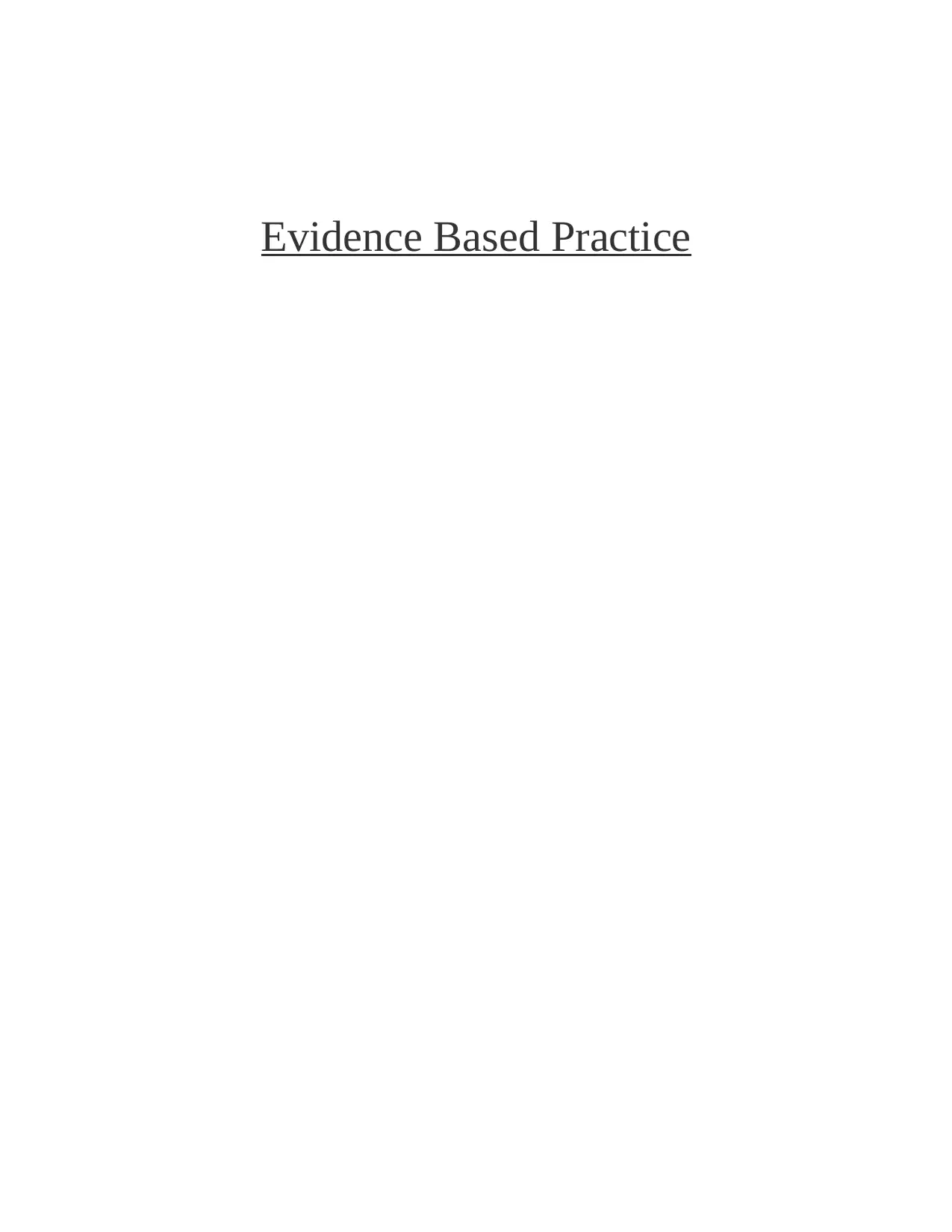
Evidence Based Practice
Secure Best Marks with AI Grader
Need help grading? Try our AI Grader for instant feedback on your assignments.
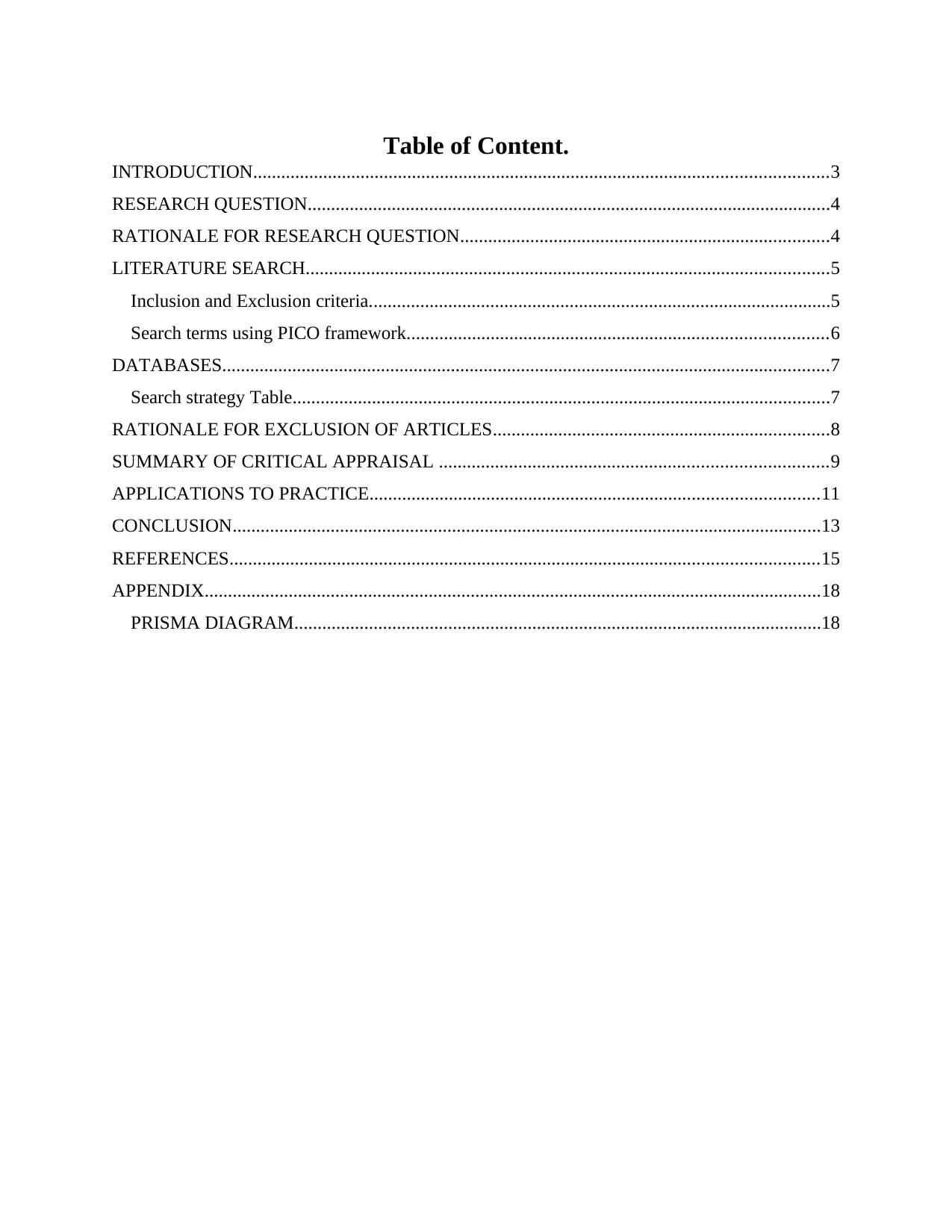
Table of Content.
INTRODUCTION...........................................................................................................................3
RESEARCH QUESTION................................................................................................................4
RATIONALE FOR RESEARCH QUESTION...............................................................................4
LITERATURE SEARCH................................................................................................................5
Inclusion and Exclusion criteria...................................................................................................5
Search terms using PICO framework..........................................................................................6
DATABASES..................................................................................................................................7
Search strategy Table...................................................................................................................7
RATIONALE FOR EXCLUSION OF ARTICLES........................................................................8
SUMMARY OF CRITICAL APPRAISAL ...................................................................................9
APPLICATIONS TO PRACTICE................................................................................................11
CONCLUSION..............................................................................................................................13
REFERENCES..............................................................................................................................15
APPENDIX....................................................................................................................................18
PRISMA DIAGRAM.................................................................................................................18
INTRODUCTION...........................................................................................................................3
RESEARCH QUESTION................................................................................................................4
RATIONALE FOR RESEARCH QUESTION...............................................................................4
LITERATURE SEARCH................................................................................................................5
Inclusion and Exclusion criteria...................................................................................................5
Search terms using PICO framework..........................................................................................6
DATABASES..................................................................................................................................7
Search strategy Table...................................................................................................................7
RATIONALE FOR EXCLUSION OF ARTICLES........................................................................8
SUMMARY OF CRITICAL APPRAISAL ...................................................................................9
APPLICATIONS TO PRACTICE................................................................................................11
CONCLUSION..............................................................................................................................13
REFERENCES..............................................................................................................................15
APPENDIX....................................................................................................................................18
PRISMA DIAGRAM.................................................................................................................18
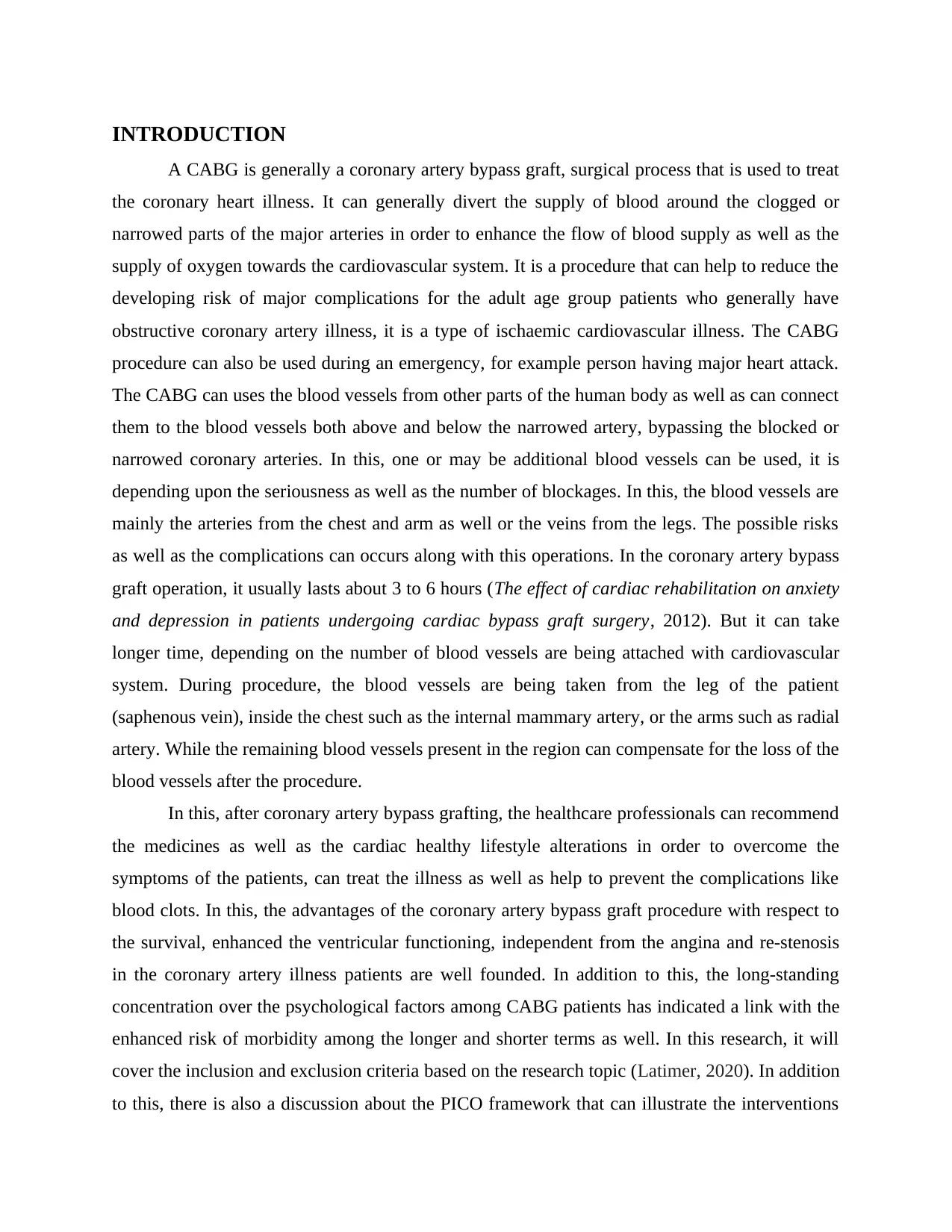
INTRODUCTION
A CABG is generally a coronary artery bypass graft, surgical process that is used to treat
the coronary heart illness. It can generally divert the supply of blood around the clogged or
narrowed parts of the major arteries in order to enhance the flow of blood supply as well as the
supply of oxygen towards the cardiovascular system. It is a procedure that can help to reduce the
developing risk of major complications for the adult age group patients who generally have
obstructive coronary artery illness, it is a type of ischaemic cardiovascular illness. The CABG
procedure can also be used during an emergency, for example person having major heart attack.
The CABG can uses the blood vessels from other parts of the human body as well as can connect
them to the blood vessels both above and below the narrowed artery, bypassing the blocked or
narrowed coronary arteries. In this, one or may be additional blood vessels can be used, it is
depending upon the seriousness as well as the number of blockages. In this, the blood vessels are
mainly the arteries from the chest and arm as well or the veins from the legs. The possible risks
as well as the complications can occurs along with this operations. In the coronary artery bypass
graft operation, it usually lasts about 3 to 6 hours (The effect of cardiac rehabilitation on anxiety
and depression in patients undergoing cardiac bypass graft surgery, 2012). But it can take
longer time, depending on the number of blood vessels are being attached with cardiovascular
system. During procedure, the blood vessels are being taken from the leg of the patient
(saphenous vein), inside the chest such as the internal mammary artery, or the arms such as radial
artery. While the remaining blood vessels present in the region can compensate for the loss of the
blood vessels after the procedure.
In this, after coronary artery bypass grafting, the healthcare professionals can recommend
the medicines as well as the cardiac healthy lifestyle alterations in order to overcome the
symptoms of the patients, can treat the illness as well as help to prevent the complications like
blood clots. In this, the advantages of the coronary artery bypass graft procedure with respect to
the survival, enhanced the ventricular functioning, independent from the angina and re-stenosis
in the coronary artery illness patients are well founded. In addition to this, the long-standing
concentration over the psychological factors among CABG patients has indicated a link with the
enhanced risk of morbidity among the longer and shorter terms as well. In this research, it will
cover the inclusion and exclusion criteria based on the research topic (Latimer, 2020). In addition
to this, there is also a discussion about the PICO framework that can illustrate the interventions
A CABG is generally a coronary artery bypass graft, surgical process that is used to treat
the coronary heart illness. It can generally divert the supply of blood around the clogged or
narrowed parts of the major arteries in order to enhance the flow of blood supply as well as the
supply of oxygen towards the cardiovascular system. It is a procedure that can help to reduce the
developing risk of major complications for the adult age group patients who generally have
obstructive coronary artery illness, it is a type of ischaemic cardiovascular illness. The CABG
procedure can also be used during an emergency, for example person having major heart attack.
The CABG can uses the blood vessels from other parts of the human body as well as can connect
them to the blood vessels both above and below the narrowed artery, bypassing the blocked or
narrowed coronary arteries. In this, one or may be additional blood vessels can be used, it is
depending upon the seriousness as well as the number of blockages. In this, the blood vessels are
mainly the arteries from the chest and arm as well or the veins from the legs. The possible risks
as well as the complications can occurs along with this operations. In the coronary artery bypass
graft operation, it usually lasts about 3 to 6 hours (The effect of cardiac rehabilitation on anxiety
and depression in patients undergoing cardiac bypass graft surgery, 2012). But it can take
longer time, depending on the number of blood vessels are being attached with cardiovascular
system. During procedure, the blood vessels are being taken from the leg of the patient
(saphenous vein), inside the chest such as the internal mammary artery, or the arms such as radial
artery. While the remaining blood vessels present in the region can compensate for the loss of the
blood vessels after the procedure.
In this, after coronary artery bypass grafting, the healthcare professionals can recommend
the medicines as well as the cardiac healthy lifestyle alterations in order to overcome the
symptoms of the patients, can treat the illness as well as help to prevent the complications like
blood clots. In this, the advantages of the coronary artery bypass graft procedure with respect to
the survival, enhanced the ventricular functioning, independent from the angina and re-stenosis
in the coronary artery illness patients are well founded. In addition to this, the long-standing
concentration over the psychological factors among CABG patients has indicated a link with the
enhanced risk of morbidity among the longer and shorter terms as well. In this research, it will
cover the inclusion and exclusion criteria based on the research topic (Latimer, 2020). In addition
to this, there is also a discussion about the PICO framework that can illustrate the interventions
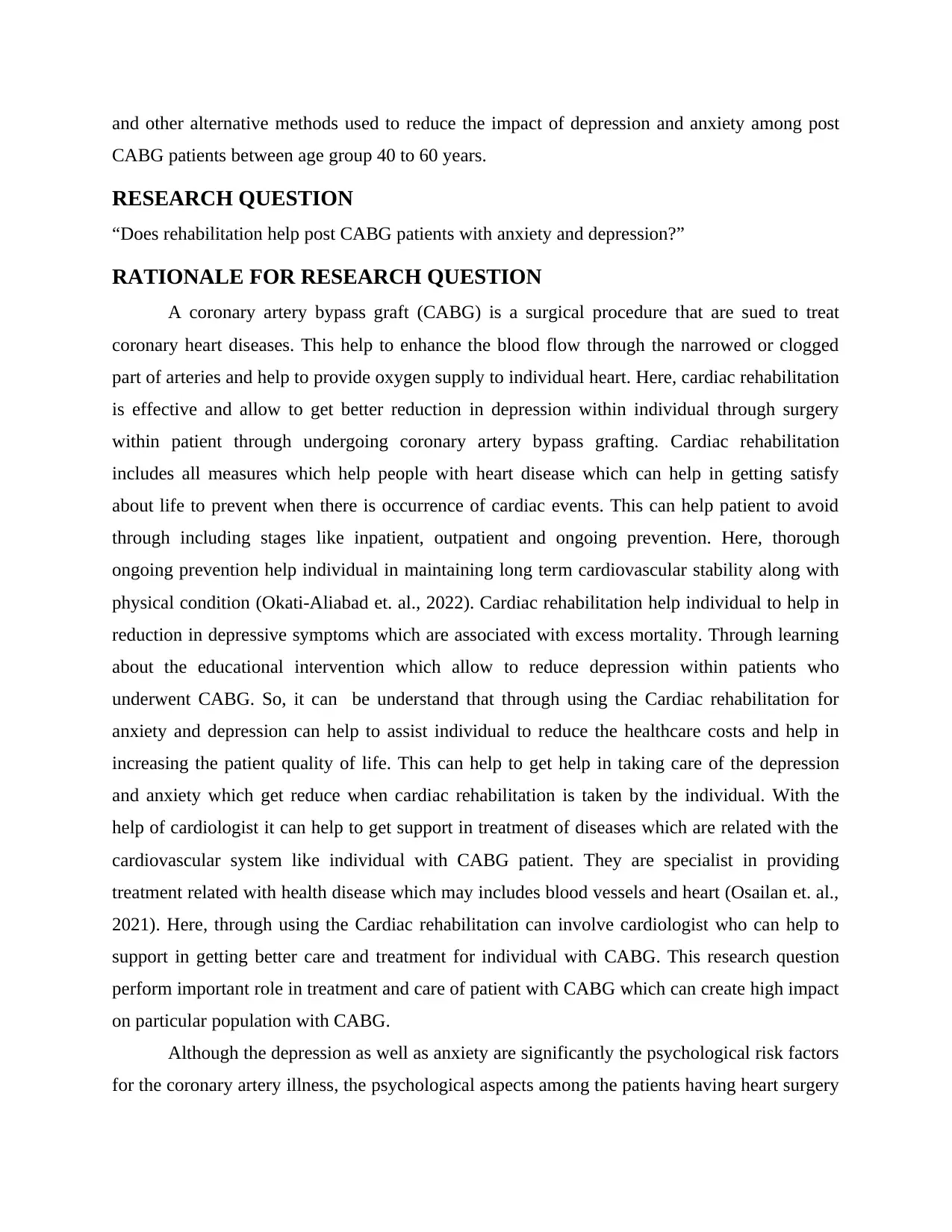
and other alternative methods used to reduce the impact of depression and anxiety among post
CABG patients between age group 40 to 60 years.
RESEARCH QUESTION
“Does rehabilitation help post CABG patients with anxiety and depression?”
RATIONALE FOR RESEARCH QUESTION
A coronary artery bypass graft (CABG) is a surgical procedure that are sued to treat
coronary heart diseases. This help to enhance the blood flow through the narrowed or clogged
part of arteries and help to provide oxygen supply to individual heart. Here, cardiac rehabilitation
is effective and allow to get better reduction in depression within individual through surgery
within patient through undergoing coronary artery bypass grafting. Cardiac rehabilitation
includes all measures which help people with heart disease which can help in getting satisfy
about life to prevent when there is occurrence of cardiac events. This can help patient to avoid
through including stages like inpatient, outpatient and ongoing prevention. Here, thorough
ongoing prevention help individual in maintaining long term cardiovascular stability along with
physical condition (Okati-Aliabad et. al., 2022). Cardiac rehabilitation help individual to help in
reduction in depressive symptoms which are associated with excess mortality. Through learning
about the educational intervention which allow to reduce depression within patients who
underwent CABG. So, it can be understand that through using the Cardiac rehabilitation for
anxiety and depression can help to assist individual to reduce the healthcare costs and help in
increasing the patient quality of life. This can help to get help in taking care of the depression
and anxiety which get reduce when cardiac rehabilitation is taken by the individual. With the
help of cardiologist it can help to get support in treatment of diseases which are related with the
cardiovascular system like individual with CABG patient. They are specialist in providing
treatment related with health disease which may includes blood vessels and heart (Osailan et. al.,
2021). Here, through using the Cardiac rehabilitation can involve cardiologist who can help to
support in getting better care and treatment for individual with CABG. This research question
perform important role in treatment and care of patient with CABG which can create high impact
on particular population with CABG.
Although the depression as well as anxiety are significantly the psychological risk factors
for the coronary artery illness, the psychological aspects among the patients having heart surgery
CABG patients between age group 40 to 60 years.
RESEARCH QUESTION
“Does rehabilitation help post CABG patients with anxiety and depression?”
RATIONALE FOR RESEARCH QUESTION
A coronary artery bypass graft (CABG) is a surgical procedure that are sued to treat
coronary heart diseases. This help to enhance the blood flow through the narrowed or clogged
part of arteries and help to provide oxygen supply to individual heart. Here, cardiac rehabilitation
is effective and allow to get better reduction in depression within individual through surgery
within patient through undergoing coronary artery bypass grafting. Cardiac rehabilitation
includes all measures which help people with heart disease which can help in getting satisfy
about life to prevent when there is occurrence of cardiac events. This can help patient to avoid
through including stages like inpatient, outpatient and ongoing prevention. Here, thorough
ongoing prevention help individual in maintaining long term cardiovascular stability along with
physical condition (Okati-Aliabad et. al., 2022). Cardiac rehabilitation help individual to help in
reduction in depressive symptoms which are associated with excess mortality. Through learning
about the educational intervention which allow to reduce depression within patients who
underwent CABG. So, it can be understand that through using the Cardiac rehabilitation for
anxiety and depression can help to assist individual to reduce the healthcare costs and help in
increasing the patient quality of life. This can help to get help in taking care of the depression
and anxiety which get reduce when cardiac rehabilitation is taken by the individual. With the
help of cardiologist it can help to get support in treatment of diseases which are related with the
cardiovascular system like individual with CABG patient. They are specialist in providing
treatment related with health disease which may includes blood vessels and heart (Osailan et. al.,
2021). Here, through using the Cardiac rehabilitation can involve cardiologist who can help to
support in getting better care and treatment for individual with CABG. This research question
perform important role in treatment and care of patient with CABG which can create high impact
on particular population with CABG.
Although the depression as well as anxiety are significantly the psychological risk factors
for the coronary artery illness, the psychological aspects among the patients having heart surgery
Secure Best Marks with AI Grader
Need help grading? Try our AI Grader for instant feedback on your assignments.
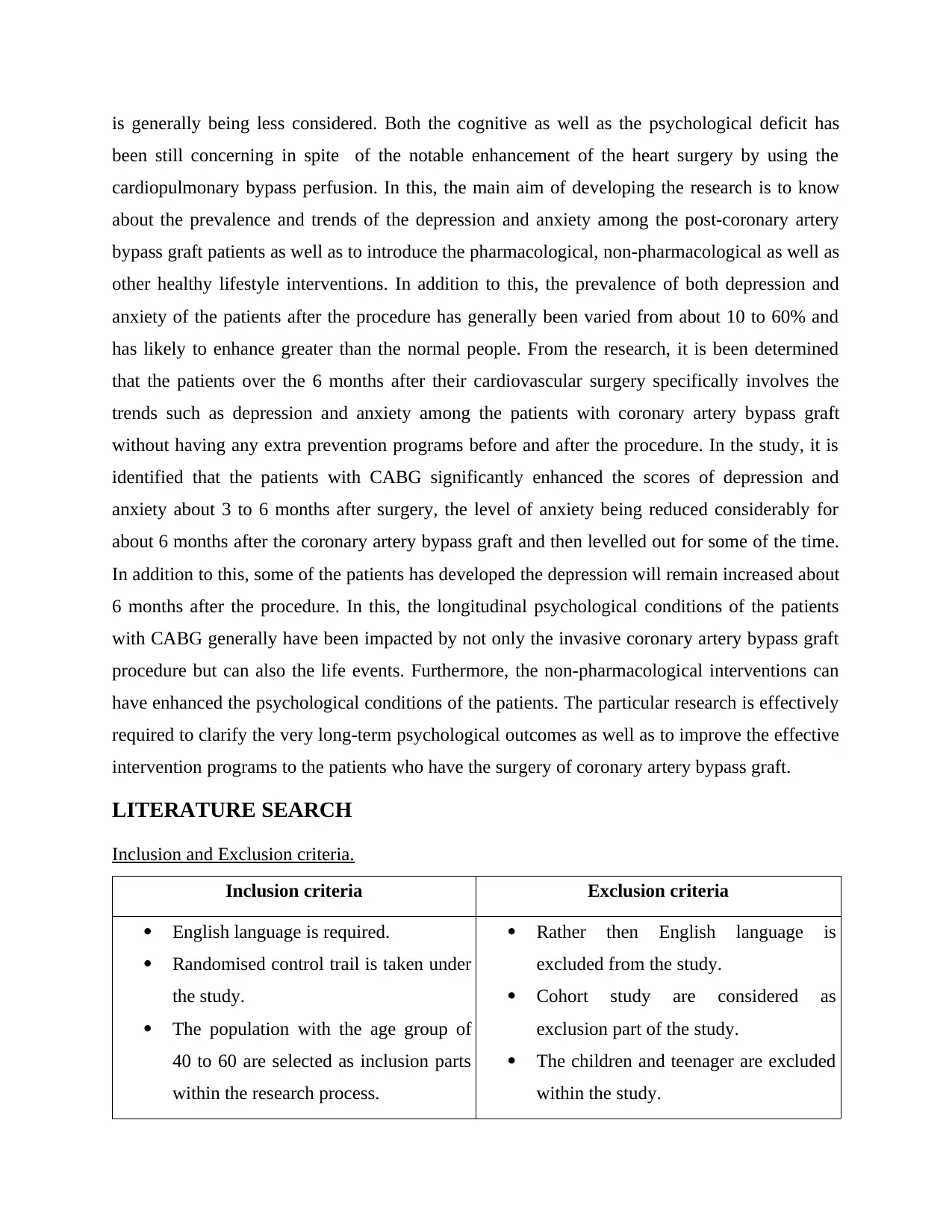
is generally being less considered. Both the cognitive as well as the psychological deficit has
been still concerning in spite of the notable enhancement of the heart surgery by using the
cardiopulmonary bypass perfusion. In this, the main aim of developing the research is to know
about the prevalence and trends of the depression and anxiety among the post-coronary artery
bypass graft patients as well as to introduce the pharmacological, non-pharmacological as well as
other healthy lifestyle interventions. In addition to this, the prevalence of both depression and
anxiety of the patients after the procedure has generally been varied from about 10 to 60% and
has likely to enhance greater than the normal people. From the research, it is been determined
that the patients over the 6 months after their cardiovascular surgery specifically involves the
trends such as depression and anxiety among the patients with coronary artery bypass graft
without having any extra prevention programs before and after the procedure. In the study, it is
identified that the patients with CABG significantly enhanced the scores of depression and
anxiety about 3 to 6 months after surgery, the level of anxiety being reduced considerably for
about 6 months after the coronary artery bypass graft and then levelled out for some of the time.
In addition to this, some of the patients has developed the depression will remain increased about
6 months after the procedure. In this, the longitudinal psychological conditions of the patients
with CABG generally have been impacted by not only the invasive coronary artery bypass graft
procedure but can also the life events. Furthermore, the non-pharmacological interventions can
have enhanced the psychological conditions of the patients. The particular research is effectively
required to clarify the very long-term psychological outcomes as well as to improve the effective
intervention programs to the patients who have the surgery of coronary artery bypass graft.
LITERATURE SEARCH
Inclusion and Exclusion criteria.
Inclusion criteria Exclusion criteria
English language is required.
Randomised control trail is taken under
the study.
The population with the age group of
40 to 60 are selected as inclusion parts
within the research process.
Rather then English language is
excluded from the study.
Cohort study are considered as
exclusion part of the study.
The children and teenager are excluded
within the study.
been still concerning in spite of the notable enhancement of the heart surgery by using the
cardiopulmonary bypass perfusion. In this, the main aim of developing the research is to know
about the prevalence and trends of the depression and anxiety among the post-coronary artery
bypass graft patients as well as to introduce the pharmacological, non-pharmacological as well as
other healthy lifestyle interventions. In addition to this, the prevalence of both depression and
anxiety of the patients after the procedure has generally been varied from about 10 to 60% and
has likely to enhance greater than the normal people. From the research, it is been determined
that the patients over the 6 months after their cardiovascular surgery specifically involves the
trends such as depression and anxiety among the patients with coronary artery bypass graft
without having any extra prevention programs before and after the procedure. In the study, it is
identified that the patients with CABG significantly enhanced the scores of depression and
anxiety about 3 to 6 months after surgery, the level of anxiety being reduced considerably for
about 6 months after the coronary artery bypass graft and then levelled out for some of the time.
In addition to this, some of the patients has developed the depression will remain increased about
6 months after the procedure. In this, the longitudinal psychological conditions of the patients
with CABG generally have been impacted by not only the invasive coronary artery bypass graft
procedure but can also the life events. Furthermore, the non-pharmacological interventions can
have enhanced the psychological conditions of the patients. The particular research is effectively
required to clarify the very long-term psychological outcomes as well as to improve the effective
intervention programs to the patients who have the surgery of coronary artery bypass graft.
LITERATURE SEARCH
Inclusion and Exclusion criteria.
Inclusion criteria Exclusion criteria
English language is required.
Randomised control trail is taken under
the study.
The population with the age group of
40 to 60 are selected as inclusion parts
within the research process.
Rather then English language is
excluded from the study.
Cohort study are considered as
exclusion part of the study.
The children and teenager are excluded
within the study.
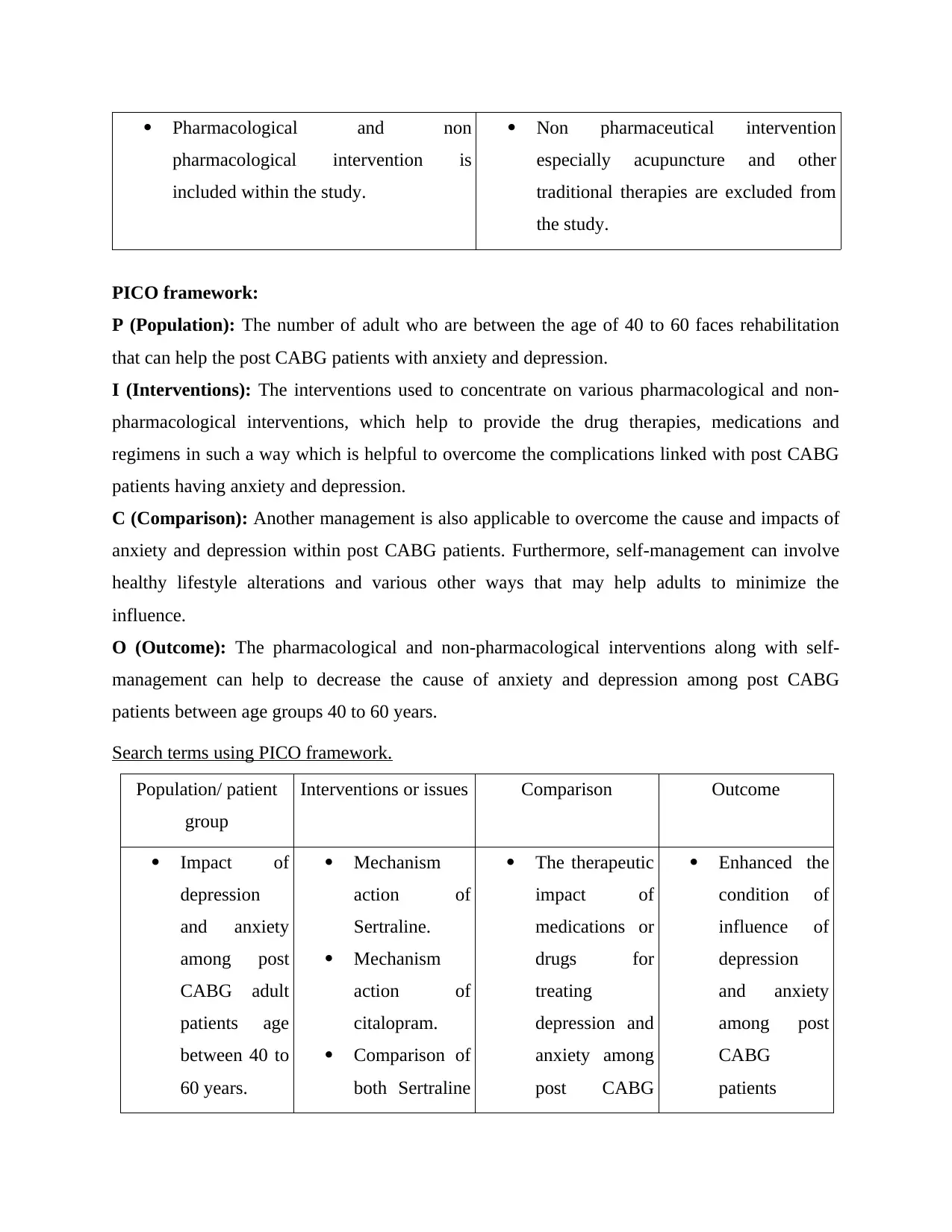
Pharmacological and non
pharmacological intervention is
included within the study.
Non pharmaceutical intervention
especially acupuncture and other
traditional therapies are excluded from
the study.
PICO framework:
P (Population): The number of adult who are between the age of 40 to 60 faces rehabilitation
that can help the post CABG patients with anxiety and depression.
I (Interventions): The interventions used to concentrate on various pharmacological and non-
pharmacological interventions, which help to provide the drug therapies, medications and
regimens in such a way which is helpful to overcome the complications linked with post CABG
patients having anxiety and depression.
C (Comparison): Another management is also applicable to overcome the cause and impacts of
anxiety and depression within post CABG patients. Furthermore, self-management can involve
healthy lifestyle alterations and various other ways that may help adults to minimize the
influence.
O (Outcome): The pharmacological and non-pharmacological interventions along with self-
management can help to decrease the cause of anxiety and depression among post CABG
patients between age groups 40 to 60 years.
Search terms using PICO framework.
Population/ patient
group
Interventions or issues Comparison Outcome
Impact of
depression
and anxiety
among post
CABG adult
patients age
between 40 to
60 years.
Mechanism
action of
Sertraline.
Mechanism
action of
citalopram.
Comparison of
both Sertraline
The therapeutic
impact of
medications or
drugs for
treating
depression and
anxiety among
post CABG
Enhanced the
condition of
influence of
depression
and anxiety
among post
CABG
patients
pharmacological intervention is
included within the study.
Non pharmaceutical intervention
especially acupuncture and other
traditional therapies are excluded from
the study.
PICO framework:
P (Population): The number of adult who are between the age of 40 to 60 faces rehabilitation
that can help the post CABG patients with anxiety and depression.
I (Interventions): The interventions used to concentrate on various pharmacological and non-
pharmacological interventions, which help to provide the drug therapies, medications and
regimens in such a way which is helpful to overcome the complications linked with post CABG
patients having anxiety and depression.
C (Comparison): Another management is also applicable to overcome the cause and impacts of
anxiety and depression within post CABG patients. Furthermore, self-management can involve
healthy lifestyle alterations and various other ways that may help adults to minimize the
influence.
O (Outcome): The pharmacological and non-pharmacological interventions along with self-
management can help to decrease the cause of anxiety and depression among post CABG
patients between age groups 40 to 60 years.
Search terms using PICO framework.
Population/ patient
group
Interventions or issues Comparison Outcome
Impact of
depression
and anxiety
among post
CABG adult
patients age
between 40 to
60 years.
Mechanism
action of
Sertraline.
Mechanism
action of
citalopram.
Comparison of
both Sertraline
The therapeutic
impact of
medications or
drugs for
treating
depression and
anxiety among
post CABG
Enhanced the
condition of
influence of
depression
and anxiety
among post
CABG
patients
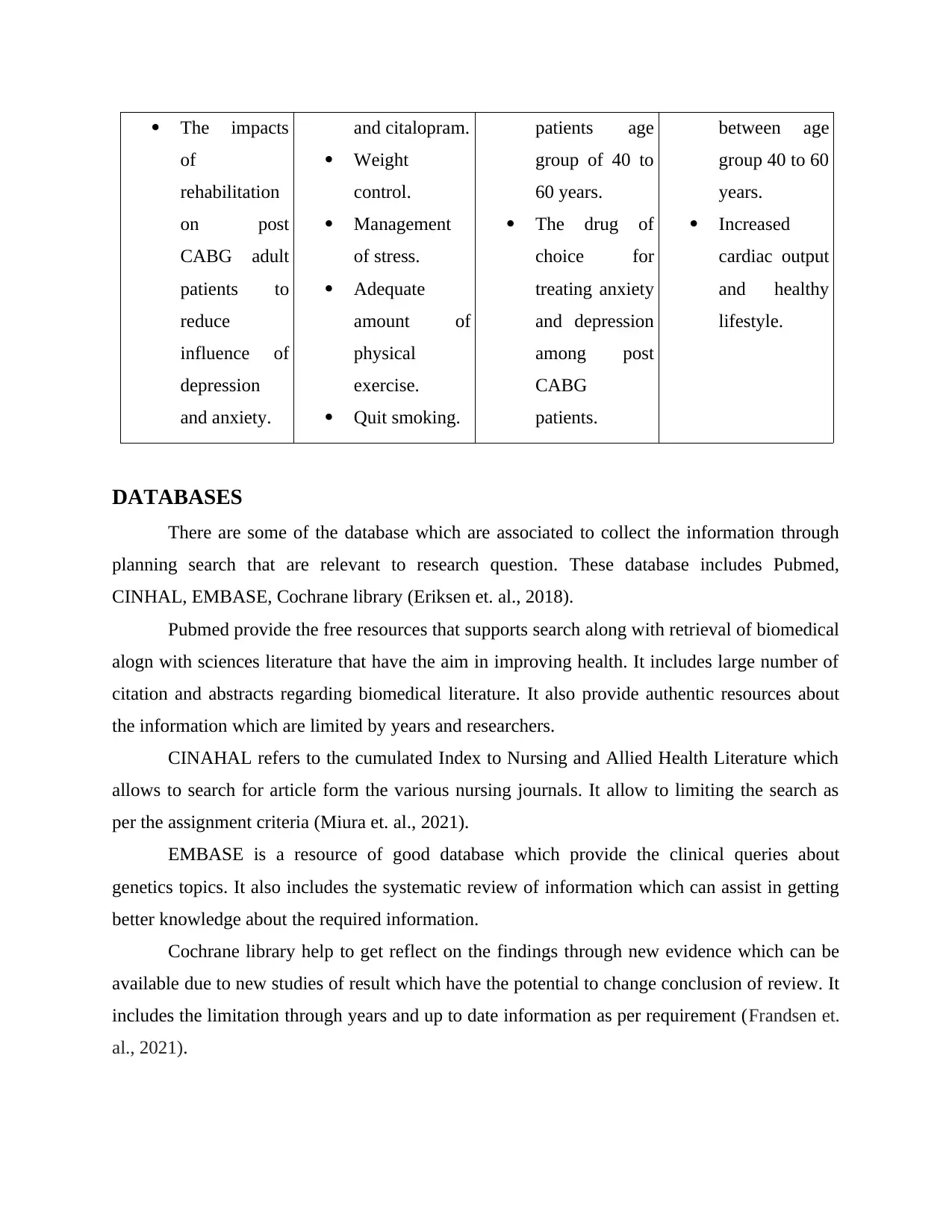
The impacts
of
rehabilitation
on post
CABG adult
patients to
reduce
influence of
depression
and anxiety.
and citalopram.
Weight
control.
Management
of stress.
Adequate
amount of
physical
exercise.
Quit smoking.
patients age
group of 40 to
60 years.
The drug of
choice for
treating anxiety
and depression
among post
CABG
patients.
between age
group 40 to 60
years.
Increased
cardiac output
and healthy
lifestyle.
DATABASES
There are some of the database which are associated to collect the information through
planning search that are relevant to research question. These database includes Pubmed,
CINHAL, EMBASE, Cochrane library (Eriksen et. al., 2018).
Pubmed provide the free resources that supports search along with retrieval of biomedical
alogn with sciences literature that have the aim in improving health. It includes large number of
citation and abstracts regarding biomedical literature. It also provide authentic resources about
the information which are limited by years and researchers.
CINAHAL refers to the cumulated Index to Nursing and Allied Health Literature which
allows to search for article form the various nursing journals. It allow to limiting the search as
per the assignment criteria (Miura et. al., 2021).
EMBASE is a resource of good database which provide the clinical queries about
genetics topics. It also includes the systematic review of information which can assist in getting
better knowledge about the required information.
Cochrane library help to get reflect on the findings through new evidence which can be
available due to new studies of result which have the potential to change conclusion of review. It
includes the limitation through years and up to date information as per requirement (Frandsen et.
al., 2021).
of
rehabilitation
on post
CABG adult
patients to
reduce
influence of
depression
and anxiety.
and citalopram.
Weight
control.
Management
of stress.
Adequate
amount of
physical
exercise.
Quit smoking.
patients age
group of 40 to
60 years.
The drug of
choice for
treating anxiety
and depression
among post
CABG
patients.
between age
group 40 to 60
years.
Increased
cardiac output
and healthy
lifestyle.
DATABASES
There are some of the database which are associated to collect the information through
planning search that are relevant to research question. These database includes Pubmed,
CINHAL, EMBASE, Cochrane library (Eriksen et. al., 2018).
Pubmed provide the free resources that supports search along with retrieval of biomedical
alogn with sciences literature that have the aim in improving health. It includes large number of
citation and abstracts regarding biomedical literature. It also provide authentic resources about
the information which are limited by years and researchers.
CINAHAL refers to the cumulated Index to Nursing and Allied Health Literature which
allows to search for article form the various nursing journals. It allow to limiting the search as
per the assignment criteria (Miura et. al., 2021).
EMBASE is a resource of good database which provide the clinical queries about
genetics topics. It also includes the systematic review of information which can assist in getting
better knowledge about the required information.
Cochrane library help to get reflect on the findings through new evidence which can be
available due to new studies of result which have the potential to change conclusion of review. It
includes the limitation through years and up to date information as per requirement (Frandsen et.
al., 2021).
Paraphrase This Document
Need a fresh take? Get an instant paraphrase of this document with our AI Paraphraser
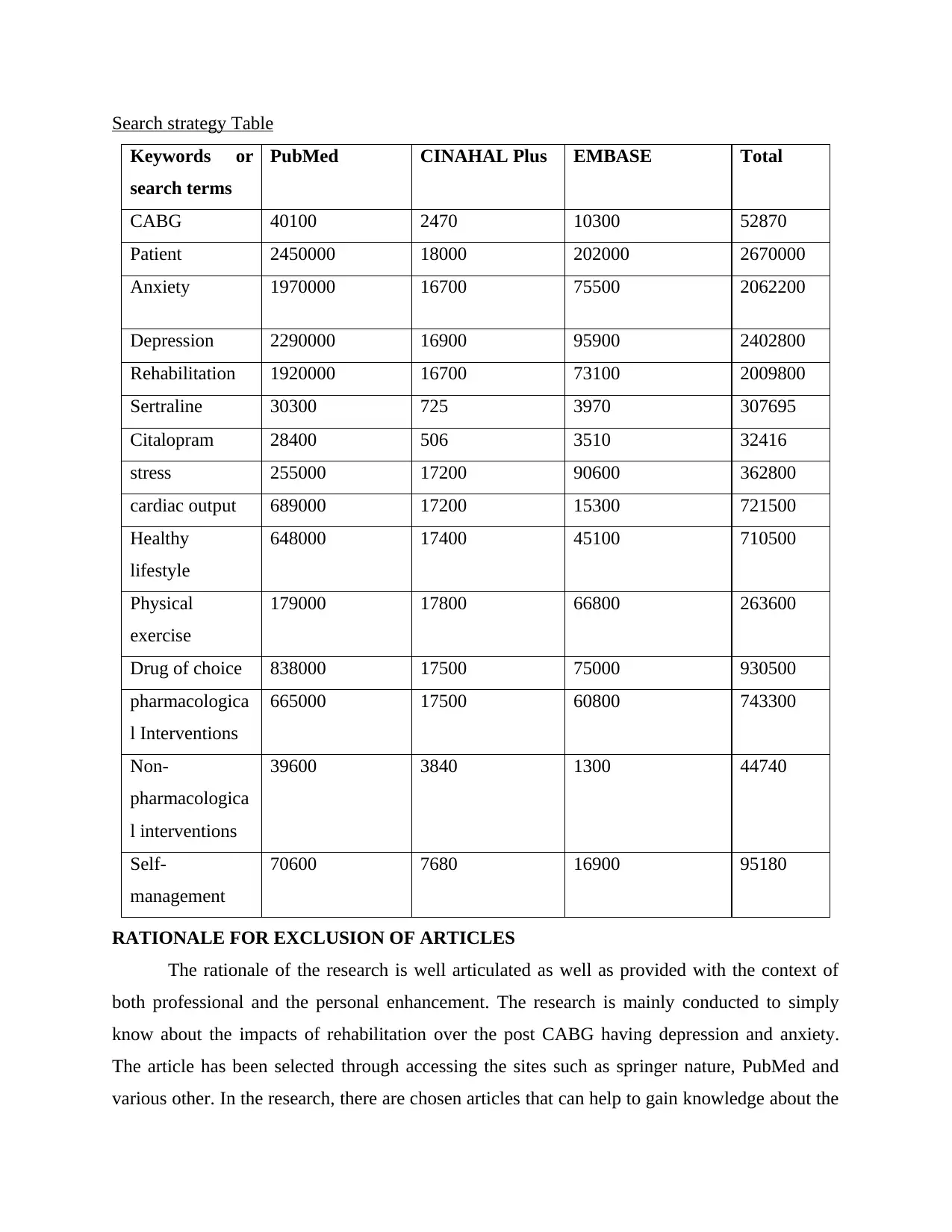
Search strategy Table
Keywords or
search terms
PubMed CINAHAL Plus EMBASE Total
CABG 40100 2470 10300 52870
Patient 2450000 18000 202000 2670000
Anxiety 1970000 16700 75500 2062200
Depression 2290000 16900 95900 2402800
Rehabilitation 1920000 16700 73100 2009800
Sertraline 30300 725 3970 307695
Citalopram 28400 506 3510 32416
stress 255000 17200 90600 362800
cardiac output 689000 17200 15300 721500
Healthy
lifestyle
648000 17400 45100 710500
Physical
exercise
179000 17800 66800 263600
Drug of choice 838000 17500 75000 930500
pharmacologica
l Interventions
665000 17500 60800 743300
Non-
pharmacologica
l interventions
39600 3840 1300 44740
Self-
management
70600 7680 16900 95180
RATIONALE FOR EXCLUSION OF ARTICLES
The rationale of the research is well articulated as well as provided with the context of
both professional and the personal enhancement. The research is mainly conducted to simply
know about the impacts of rehabilitation over the post CABG having depression and anxiety.
The article has been selected through accessing the sites such as springer nature, PubMed and
various other. In the research, there are chosen articles that can help to gain knowledge about the
Keywords or
search terms
PubMed CINAHAL Plus EMBASE Total
CABG 40100 2470 10300 52870
Patient 2450000 18000 202000 2670000
Anxiety 1970000 16700 75500 2062200
Depression 2290000 16900 95900 2402800
Rehabilitation 1920000 16700 73100 2009800
Sertraline 30300 725 3970 307695
Citalopram 28400 506 3510 32416
stress 255000 17200 90600 362800
cardiac output 689000 17200 15300 721500
Healthy
lifestyle
648000 17400 45100 710500
Physical
exercise
179000 17800 66800 263600
Drug of choice 838000 17500 75000 930500
pharmacologica
l Interventions
665000 17500 60800 743300
Non-
pharmacologica
l interventions
39600 3840 1300 44740
Self-
management
70600 7680 16900 95180
RATIONALE FOR EXCLUSION OF ARTICLES
The rationale of the research is well articulated as well as provided with the context of
both professional and the personal enhancement. The research is mainly conducted to simply
know about the impacts of rehabilitation over the post CABG having depression and anxiety.
The article has been selected through accessing the sites such as springer nature, PubMed and
various other. In the research, there are chosen articles that can help to gain knowledge about the
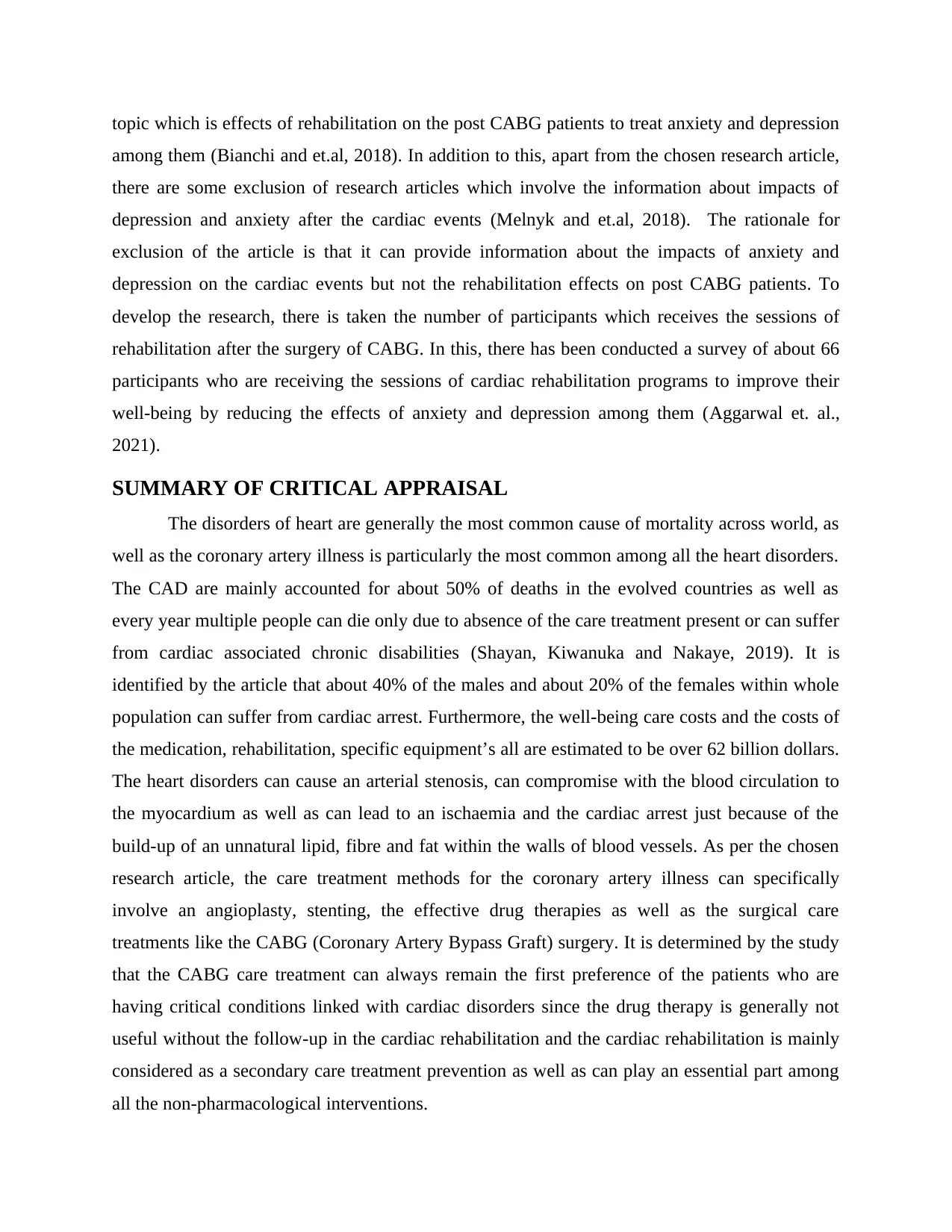
topic which is effects of rehabilitation on the post CABG patients to treat anxiety and depression
among them (Bianchi and et.al, 2018). In addition to this, apart from the chosen research article,
there are some exclusion of research articles which involve the information about impacts of
depression and anxiety after the cardiac events (Melnyk and et.al, 2018). The rationale for
exclusion of the article is that it can provide information about the impacts of anxiety and
depression on the cardiac events but not the rehabilitation effects on post CABG patients. To
develop the research, there is taken the number of participants which receives the sessions of
rehabilitation after the surgery of CABG. In this, there has been conducted a survey of about 66
participants who are receiving the sessions of cardiac rehabilitation programs to improve their
well-being by reducing the effects of anxiety and depression among them (Aggarwal et. al.,
2021).
SUMMARY OF CRITICAL APPRAISAL
The disorders of heart are generally the most common cause of mortality across world, as
well as the coronary artery illness is particularly the most common among all the heart disorders.
The CAD are mainly accounted for about 50% of deaths in the evolved countries as well as
every year multiple people can die only due to absence of the care treatment present or can suffer
from cardiac associated chronic disabilities (Shayan, Kiwanuka and Nakaye, 2019). It is
identified by the article that about 40% of the males and about 20% of the females within whole
population can suffer from cardiac arrest. Furthermore, the well-being care costs and the costs of
the medication, rehabilitation, specific equipment’s all are estimated to be over 62 billion dollars.
The heart disorders can cause an arterial stenosis, can compromise with the blood circulation to
the myocardium as well as can lead to an ischaemia and the cardiac arrest just because of the
build-up of an unnatural lipid, fibre and fat within the walls of blood vessels. As per the chosen
research article, the care treatment methods for the coronary artery illness can specifically
involve an angioplasty, stenting, the effective drug therapies as well as the surgical care
treatments like the CABG (Coronary Artery Bypass Graft) surgery. It is determined by the study
that the CABG care treatment can always remain the first preference of the patients who are
having critical conditions linked with cardiac disorders since the drug therapy is generally not
useful without the follow-up in the cardiac rehabilitation and the cardiac rehabilitation is mainly
considered as a secondary care treatment prevention as well as can play an essential part among
all the non-pharmacological interventions.
among them (Bianchi and et.al, 2018). In addition to this, apart from the chosen research article,
there are some exclusion of research articles which involve the information about impacts of
depression and anxiety after the cardiac events (Melnyk and et.al, 2018). The rationale for
exclusion of the article is that it can provide information about the impacts of anxiety and
depression on the cardiac events but not the rehabilitation effects on post CABG patients. To
develop the research, there is taken the number of participants which receives the sessions of
rehabilitation after the surgery of CABG. In this, there has been conducted a survey of about 66
participants who are receiving the sessions of cardiac rehabilitation programs to improve their
well-being by reducing the effects of anxiety and depression among them (Aggarwal et. al.,
2021).
SUMMARY OF CRITICAL APPRAISAL
The disorders of heart are generally the most common cause of mortality across world, as
well as the coronary artery illness is particularly the most common among all the heart disorders.
The CAD are mainly accounted for about 50% of deaths in the evolved countries as well as
every year multiple people can die only due to absence of the care treatment present or can suffer
from cardiac associated chronic disabilities (Shayan, Kiwanuka and Nakaye, 2019). It is
identified by the article that about 40% of the males and about 20% of the females within whole
population can suffer from cardiac arrest. Furthermore, the well-being care costs and the costs of
the medication, rehabilitation, specific equipment’s all are estimated to be over 62 billion dollars.
The heart disorders can cause an arterial stenosis, can compromise with the blood circulation to
the myocardium as well as can lead to an ischaemia and the cardiac arrest just because of the
build-up of an unnatural lipid, fibre and fat within the walls of blood vessels. As per the chosen
research article, the care treatment methods for the coronary artery illness can specifically
involve an angioplasty, stenting, the effective drug therapies as well as the surgical care
treatments like the CABG (Coronary Artery Bypass Graft) surgery. It is determined by the study
that the CABG care treatment can always remain the first preference of the patients who are
having critical conditions linked with cardiac disorders since the drug therapy is generally not
useful without the follow-up in the cardiac rehabilitation and the cardiac rehabilitation is mainly
considered as a secondary care treatment prevention as well as can play an essential part among
all the non-pharmacological interventions.
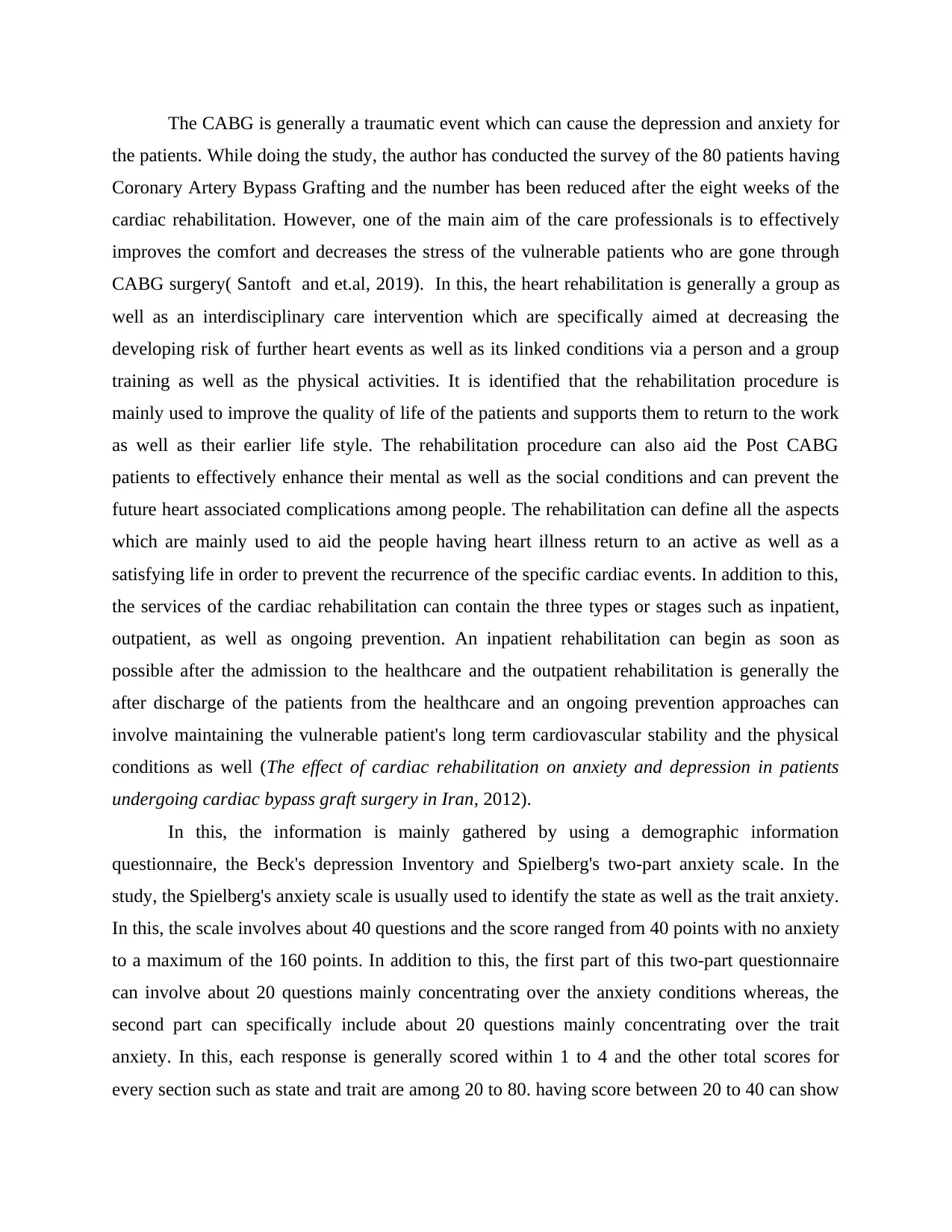
The CABG is generally a traumatic event which can cause the depression and anxiety for
the patients. While doing the study, the author has conducted the survey of the 80 patients having
Coronary Artery Bypass Grafting and the number has been reduced after the eight weeks of the
cardiac rehabilitation. However, one of the main aim of the care professionals is to effectively
improves the comfort and decreases the stress of the vulnerable patients who are gone through
CABG surgery( Santoft and et.al, 2019). In this, the heart rehabilitation is generally a group as
well as an interdisciplinary care intervention which are specifically aimed at decreasing the
developing risk of further heart events as well as its linked conditions via a person and a group
training as well as the physical activities. It is identified that the rehabilitation procedure is
mainly used to improve the quality of life of the patients and supports them to return to the work
as well as their earlier life style. The rehabilitation procedure can also aid the Post CABG
patients to effectively enhance their mental as well as the social conditions and can prevent the
future heart associated complications among people. The rehabilitation can define all the aspects
which are mainly used to aid the people having heart illness return to an active as well as a
satisfying life in order to prevent the recurrence of the specific cardiac events. In addition to this,
the services of the cardiac rehabilitation can contain the three types or stages such as inpatient,
outpatient, as well as ongoing prevention. An inpatient rehabilitation can begin as soon as
possible after the admission to the healthcare and the outpatient rehabilitation is generally the
after discharge of the patients from the healthcare and an ongoing prevention approaches can
involve maintaining the vulnerable patient's long term cardiovascular stability and the physical
conditions as well (The effect of cardiac rehabilitation on anxiety and depression in patients
undergoing cardiac bypass graft surgery in Iran, 2012).
In this, the information is mainly gathered by using a demographic information
questionnaire, the Beck's depression Inventory and Spielberg's two-part anxiety scale. In the
study, the Spielberg's anxiety scale is usually used to identify the state as well as the trait anxiety.
In this, the scale involves about 40 questions and the score ranged from 40 points with no anxiety
to a maximum of the 160 points. In addition to this, the first part of this two-part questionnaire
can involve about 20 questions mainly concentrating over the anxiety conditions whereas, the
second part can specifically include about 20 questions mainly concentrating over the trait
anxiety. In this, each response is generally scored within 1 to 4 and the other total scores for
every section such as state and trait are among 20 to 80. having score between 20 to 40 can show
the patients. While doing the study, the author has conducted the survey of the 80 patients having
Coronary Artery Bypass Grafting and the number has been reduced after the eight weeks of the
cardiac rehabilitation. However, one of the main aim of the care professionals is to effectively
improves the comfort and decreases the stress of the vulnerable patients who are gone through
CABG surgery( Santoft and et.al, 2019). In this, the heart rehabilitation is generally a group as
well as an interdisciplinary care intervention which are specifically aimed at decreasing the
developing risk of further heart events as well as its linked conditions via a person and a group
training as well as the physical activities. It is identified that the rehabilitation procedure is
mainly used to improve the quality of life of the patients and supports them to return to the work
as well as their earlier life style. The rehabilitation procedure can also aid the Post CABG
patients to effectively enhance their mental as well as the social conditions and can prevent the
future heart associated complications among people. The rehabilitation can define all the aspects
which are mainly used to aid the people having heart illness return to an active as well as a
satisfying life in order to prevent the recurrence of the specific cardiac events. In addition to this,
the services of the cardiac rehabilitation can contain the three types or stages such as inpatient,
outpatient, as well as ongoing prevention. An inpatient rehabilitation can begin as soon as
possible after the admission to the healthcare and the outpatient rehabilitation is generally the
after discharge of the patients from the healthcare and an ongoing prevention approaches can
involve maintaining the vulnerable patient's long term cardiovascular stability and the physical
conditions as well (The effect of cardiac rehabilitation on anxiety and depression in patients
undergoing cardiac bypass graft surgery in Iran, 2012).
In this, the information is mainly gathered by using a demographic information
questionnaire, the Beck's depression Inventory and Spielberg's two-part anxiety scale. In the
study, the Spielberg's anxiety scale is usually used to identify the state as well as the trait anxiety.
In this, the scale involves about 40 questions and the score ranged from 40 points with no anxiety
to a maximum of the 160 points. In addition to this, the first part of this two-part questionnaire
can involve about 20 questions mainly concentrating over the anxiety conditions whereas, the
second part can specifically include about 20 questions mainly concentrating over the trait
anxiety. In this, each response is generally scored within 1 to 4 and the other total scores for
every section such as state and trait are among 20 to 80. having score between 20 to 40 can show
Secure Best Marks with AI Grader
Need help grading? Try our AI Grader for instant feedback on your assignments.

a mild anxiety, the score range between 41 to 60 express the moderate anxiety and above till 80
can depict critical anxiety conditions. Therefore, the reported the reliability and validity of the
questionnaire. In this, the Beck's depression Inventory is generally used the screening
instruments for the depression among the public. In addition to this, the self-questionnaire is
mainly used to evaluate the anxiety and depression levels among the Post CABG patients and to
determine the anxiety and depression levels in other people as well (Boreskie et. al., 2019).
APPLICATIONS TO PRACTICE
The randomised controlled trails, meta-analysis and a systematic review has been
conducted on the cardiac rehabilitation programs, some of them are effectively decreased the
mortality rates, enhanced quality of life and readmission within healthcare as well as an
enhancement of the cardiac associated parameters which is the overall cholesterol. The self-
reporting estimates of depression and anxiety are variable. Having anxiety is mainly high for the
post CABG patients and to reduce the impacts of this, there are the rehabilitation programs. Most
of the patients have fear of dying before instead of during the procedure has been depicted as an
anxious and a pervasive preoccupation. The anxiety disorders can effectively manifest as an
autonomic symptom which can further exacerbate the symptoms of Coronary artery bypass graft.
After having the procedure, the anxiety levels can be reduced to the below operative levels, the
critical of the anxiety does not remit to below the sub-clinical levels as well as can specifically
sanction the effective interventions. Unlike depression, an accurate and complicating
identification of an anxious patients over the course of surgery recovery is the finding that an
autonomic-arousal symptom specifically enhances after the procedure of CABG. It is generally
surprising given the overlap as well as apparently identical characteristics of the coronary artery
disorder as well as a somatic anxiety symptom such as enhanced heart rates and breathlessness.
In this, the very common anxiety illness generally appears to be GAD (general anxiety disorder),
an illness generally marked by the pervasive worry as well as a panic disorder, mainly exhibited
by the recurrent panic attacks. While doing survey, it is found that there has been a voluntary
written informed consent that was obtained from every patient who are participated. The
professionals generally interviewed all the patients in order to collect the demographic
information’s as well as effectively completed the BAI (Beck Anxiety Inventory) as well as BDI-
II (Beck Depression Inventory-II) questionnaires before initiation of the cardiac rehabilitation
programs.
can depict critical anxiety conditions. Therefore, the reported the reliability and validity of the
questionnaire. In this, the Beck's depression Inventory is generally used the screening
instruments for the depression among the public. In addition to this, the self-questionnaire is
mainly used to evaluate the anxiety and depression levels among the Post CABG patients and to
determine the anxiety and depression levels in other people as well (Boreskie et. al., 2019).
APPLICATIONS TO PRACTICE
The randomised controlled trails, meta-analysis and a systematic review has been
conducted on the cardiac rehabilitation programs, some of them are effectively decreased the
mortality rates, enhanced quality of life and readmission within healthcare as well as an
enhancement of the cardiac associated parameters which is the overall cholesterol. The self-
reporting estimates of depression and anxiety are variable. Having anxiety is mainly high for the
post CABG patients and to reduce the impacts of this, there are the rehabilitation programs. Most
of the patients have fear of dying before instead of during the procedure has been depicted as an
anxious and a pervasive preoccupation. The anxiety disorders can effectively manifest as an
autonomic symptom which can further exacerbate the symptoms of Coronary artery bypass graft.
After having the procedure, the anxiety levels can be reduced to the below operative levels, the
critical of the anxiety does not remit to below the sub-clinical levels as well as can specifically
sanction the effective interventions. Unlike depression, an accurate and complicating
identification of an anxious patients over the course of surgery recovery is the finding that an
autonomic-arousal symptom specifically enhances after the procedure of CABG. It is generally
surprising given the overlap as well as apparently identical characteristics of the coronary artery
disorder as well as a somatic anxiety symptom such as enhanced heart rates and breathlessness.
In this, the very common anxiety illness generally appears to be GAD (general anxiety disorder),
an illness generally marked by the pervasive worry as well as a panic disorder, mainly exhibited
by the recurrent panic attacks. While doing survey, it is found that there has been a voluntary
written informed consent that was obtained from every patient who are participated. The
professionals generally interviewed all the patients in order to collect the demographic
information’s as well as effectively completed the BAI (Beck Anxiety Inventory) as well as BDI-
II (Beck Depression Inventory-II) questionnaires before initiation of the cardiac rehabilitation
programs.
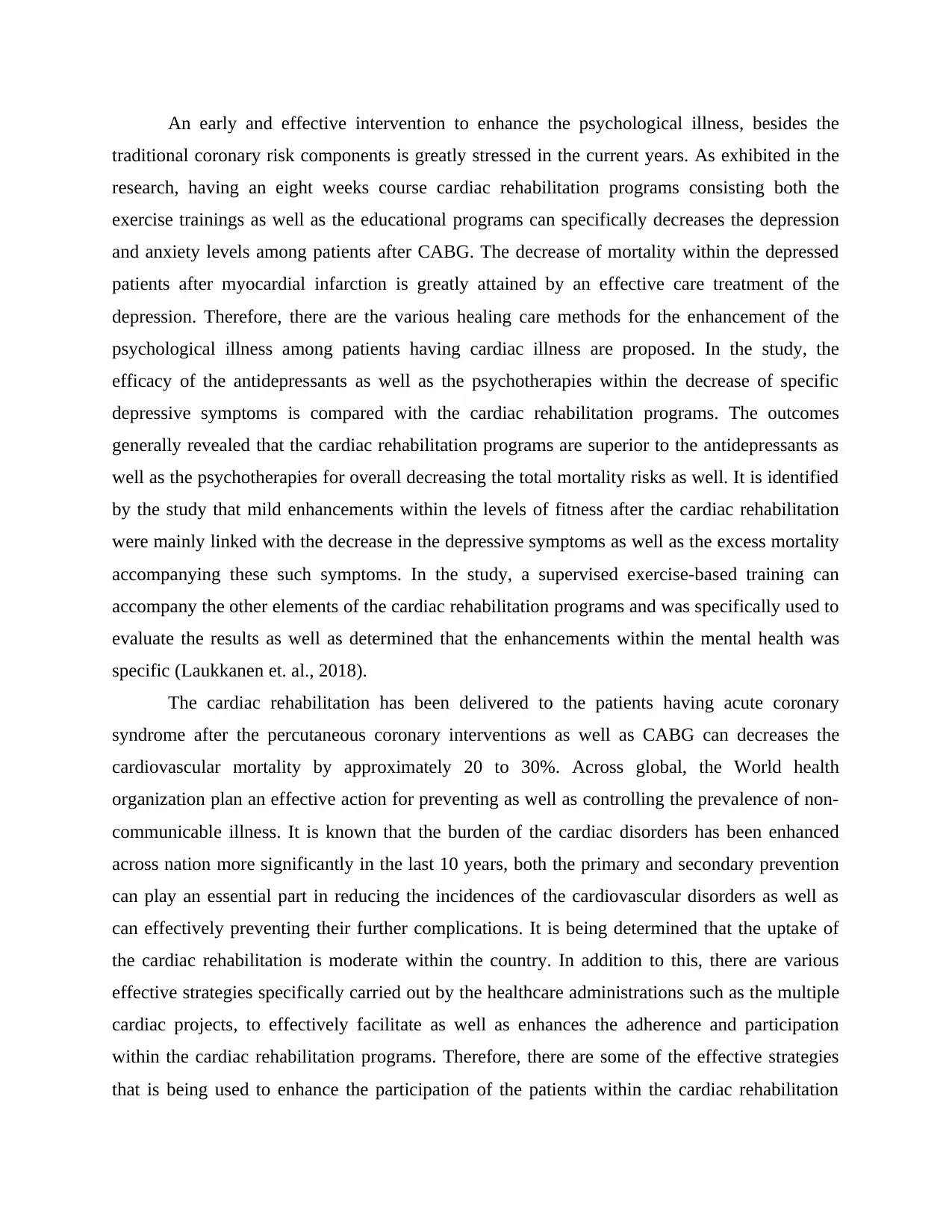
An early and effective intervention to enhance the psychological illness, besides the
traditional coronary risk components is greatly stressed in the current years. As exhibited in the
research, having an eight weeks course cardiac rehabilitation programs consisting both the
exercise trainings as well as the educational programs can specifically decreases the depression
and anxiety levels among patients after CABG. The decrease of mortality within the depressed
patients after myocardial infarction is greatly attained by an effective care treatment of the
depression. Therefore, there are the various healing care methods for the enhancement of the
psychological illness among patients having cardiac illness are proposed. In the study, the
efficacy of the antidepressants as well as the psychotherapies within the decrease of specific
depressive symptoms is compared with the cardiac rehabilitation programs. The outcomes
generally revealed that the cardiac rehabilitation programs are superior to the antidepressants as
well as the psychotherapies for overall decreasing the total mortality risks as well. It is identified
by the study that mild enhancements within the levels of fitness after the cardiac rehabilitation
were mainly linked with the decrease in the depressive symptoms as well as the excess mortality
accompanying these such symptoms. In the study, a supervised exercise-based training can
accompany the other elements of the cardiac rehabilitation programs and was specifically used to
evaluate the results as well as determined that the enhancements within the mental health was
specific (Laukkanen et. al., 2018).
The cardiac rehabilitation has been delivered to the patients having acute coronary
syndrome after the percutaneous coronary interventions as well as CABG can decreases the
cardiovascular mortality by approximately 20 to 30%. Across global, the World health
organization plan an effective action for preventing as well as controlling the prevalence of non-
communicable illness. It is known that the burden of the cardiac disorders has been enhanced
across nation more significantly in the last 10 years, both the primary and secondary prevention
can play an essential part in reducing the incidences of the cardiovascular disorders as well as
can effectively preventing their further complications. It is being determined that the uptake of
the cardiac rehabilitation is moderate within the country. In addition to this, there are various
effective strategies specifically carried out by the healthcare administrations such as the multiple
cardiac projects, to effectively facilitate as well as enhances the adherence and participation
within the cardiac rehabilitation programs. Therefore, there are some of the effective strategies
that is being used to enhance the participation of the patients within the cardiac rehabilitation
traditional coronary risk components is greatly stressed in the current years. As exhibited in the
research, having an eight weeks course cardiac rehabilitation programs consisting both the
exercise trainings as well as the educational programs can specifically decreases the depression
and anxiety levels among patients after CABG. The decrease of mortality within the depressed
patients after myocardial infarction is greatly attained by an effective care treatment of the
depression. Therefore, there are the various healing care methods for the enhancement of the
psychological illness among patients having cardiac illness are proposed. In the study, the
efficacy of the antidepressants as well as the psychotherapies within the decrease of specific
depressive symptoms is compared with the cardiac rehabilitation programs. The outcomes
generally revealed that the cardiac rehabilitation programs are superior to the antidepressants as
well as the psychotherapies for overall decreasing the total mortality risks as well. It is identified
by the study that mild enhancements within the levels of fitness after the cardiac rehabilitation
were mainly linked with the decrease in the depressive symptoms as well as the excess mortality
accompanying these such symptoms. In the study, a supervised exercise-based training can
accompany the other elements of the cardiac rehabilitation programs and was specifically used to
evaluate the results as well as determined that the enhancements within the mental health was
specific (Laukkanen et. al., 2018).
The cardiac rehabilitation has been delivered to the patients having acute coronary
syndrome after the percutaneous coronary interventions as well as CABG can decreases the
cardiovascular mortality by approximately 20 to 30%. Across global, the World health
organization plan an effective action for preventing as well as controlling the prevalence of non-
communicable illness. It is known that the burden of the cardiac disorders has been enhanced
across nation more significantly in the last 10 years, both the primary and secondary prevention
can play an essential part in reducing the incidences of the cardiovascular disorders as well as
can effectively preventing their further complications. It is being determined that the uptake of
the cardiac rehabilitation is moderate within the country. In addition to this, there are various
effective strategies specifically carried out by the healthcare administrations such as the multiple
cardiac projects, to effectively facilitate as well as enhances the adherence and participation
within the cardiac rehabilitation programs. Therefore, there are some of the effective strategies
that is being used to enhance the participation of the patients within the cardiac rehabilitation
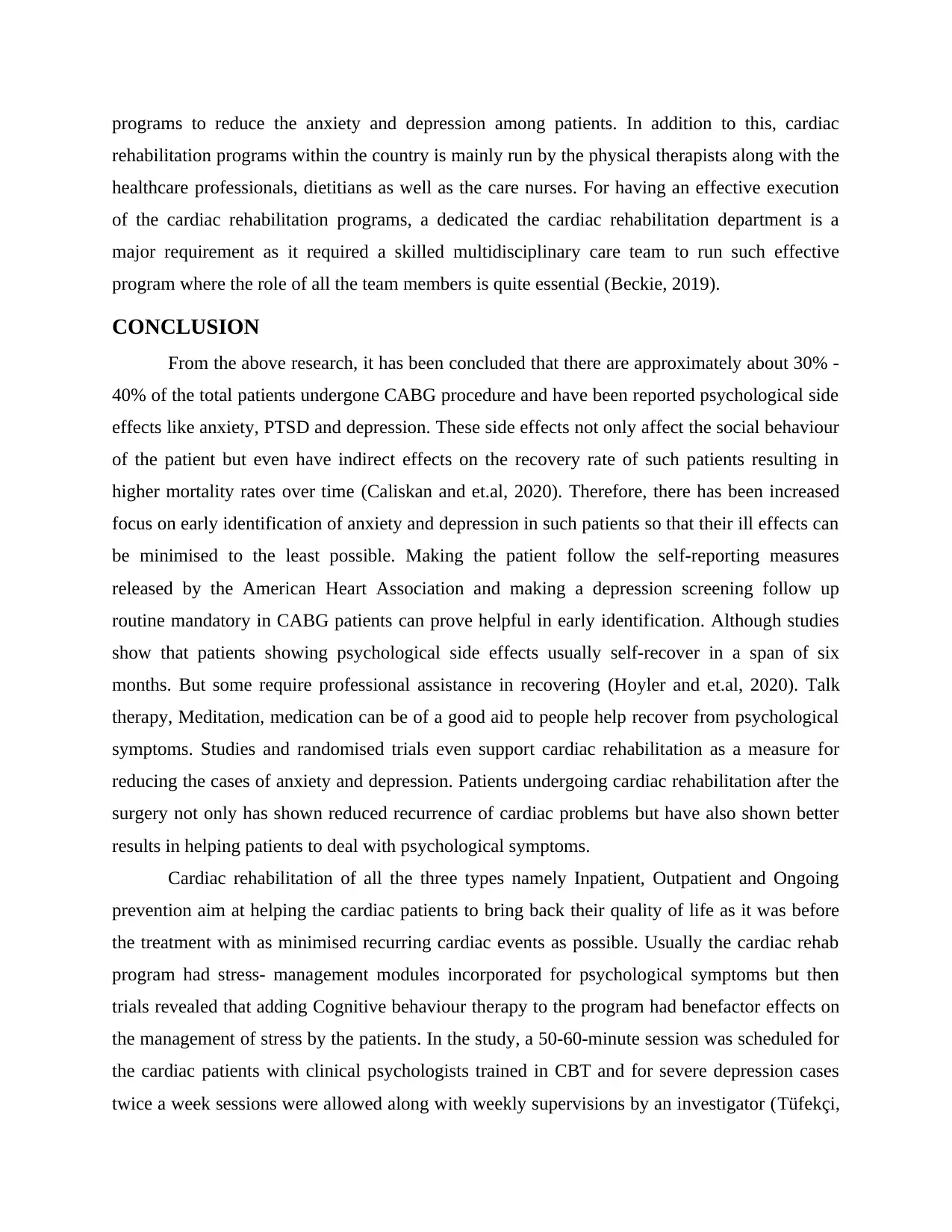
programs to reduce the anxiety and depression among patients. In addition to this, cardiac
rehabilitation programs within the country is mainly run by the physical therapists along with the
healthcare professionals, dietitians as well as the care nurses. For having an effective execution
of the cardiac rehabilitation programs, a dedicated the cardiac rehabilitation department is a
major requirement as it required a skilled multidisciplinary care team to run such effective
program where the role of all the team members is quite essential (Beckie, 2019).
CONCLUSION
From the above research, it has been concluded that there are approximately about 30% -
40% of the total patients undergone CABG procedure and have been reported psychological side
effects like anxiety, PTSD and depression. These side effects not only affect the social behaviour
of the patient but even have indirect effects on the recovery rate of such patients resulting in
higher mortality rates over time (Caliskan and et.al, 2020). Therefore, there has been increased
focus on early identification of anxiety and depression in such patients so that their ill effects can
be minimised to the least possible. Making the patient follow the self-reporting measures
released by the American Heart Association and making a depression screening follow up
routine mandatory in CABG patients can prove helpful in early identification. Although studies
show that patients showing psychological side effects usually self-recover in a span of six
months. But some require professional assistance in recovering (Hoyler and et.al, 2020). Talk
therapy, Meditation, medication can be of a good aid to people help recover from psychological
symptoms. Studies and randomised trials even support cardiac rehabilitation as a measure for
reducing the cases of anxiety and depression. Patients undergoing cardiac rehabilitation after the
surgery not only has shown reduced recurrence of cardiac problems but have also shown better
results in helping patients to deal with psychological symptoms.
Cardiac rehabilitation of all the three types namely Inpatient, Outpatient and Ongoing
prevention aim at helping the cardiac patients to bring back their quality of life as it was before
the treatment with as minimised recurring cardiac events as possible. Usually the cardiac rehab
program had stress- management modules incorporated for psychological symptoms but then
trials revealed that adding Cognitive behaviour therapy to the program had benefactor effects on
the management of stress by the patients. In the study, a 50-60-minute session was scheduled for
the cardiac patients with clinical psychologists trained in CBT and for severe depression cases
twice a week sessions were allowed along with weekly supervisions by an investigator (Tüfekçi,
rehabilitation programs within the country is mainly run by the physical therapists along with the
healthcare professionals, dietitians as well as the care nurses. For having an effective execution
of the cardiac rehabilitation programs, a dedicated the cardiac rehabilitation department is a
major requirement as it required a skilled multidisciplinary care team to run such effective
program where the role of all the team members is quite essential (Beckie, 2019).
CONCLUSION
From the above research, it has been concluded that there are approximately about 30% -
40% of the total patients undergone CABG procedure and have been reported psychological side
effects like anxiety, PTSD and depression. These side effects not only affect the social behaviour
of the patient but even have indirect effects on the recovery rate of such patients resulting in
higher mortality rates over time (Caliskan and et.al, 2020). Therefore, there has been increased
focus on early identification of anxiety and depression in such patients so that their ill effects can
be minimised to the least possible. Making the patient follow the self-reporting measures
released by the American Heart Association and making a depression screening follow up
routine mandatory in CABG patients can prove helpful in early identification. Although studies
show that patients showing psychological side effects usually self-recover in a span of six
months. But some require professional assistance in recovering (Hoyler and et.al, 2020). Talk
therapy, Meditation, medication can be of a good aid to people help recover from psychological
symptoms. Studies and randomised trials even support cardiac rehabilitation as a measure for
reducing the cases of anxiety and depression. Patients undergoing cardiac rehabilitation after the
surgery not only has shown reduced recurrence of cardiac problems but have also shown better
results in helping patients to deal with psychological symptoms.
Cardiac rehabilitation of all the three types namely Inpatient, Outpatient and Ongoing
prevention aim at helping the cardiac patients to bring back their quality of life as it was before
the treatment with as minimised recurring cardiac events as possible. Usually the cardiac rehab
program had stress- management modules incorporated for psychological symptoms but then
trials revealed that adding Cognitive behaviour therapy to the program had benefactor effects on
the management of stress by the patients. In the study, a 50-60-minute session was scheduled for
the cardiac patients with clinical psychologists trained in CBT and for severe depression cases
twice a week sessions were allowed along with weekly supervisions by an investigator (Tüfekçi,
Paraphrase This Document
Need a fresh take? Get an instant paraphrase of this document with our AI Paraphraser
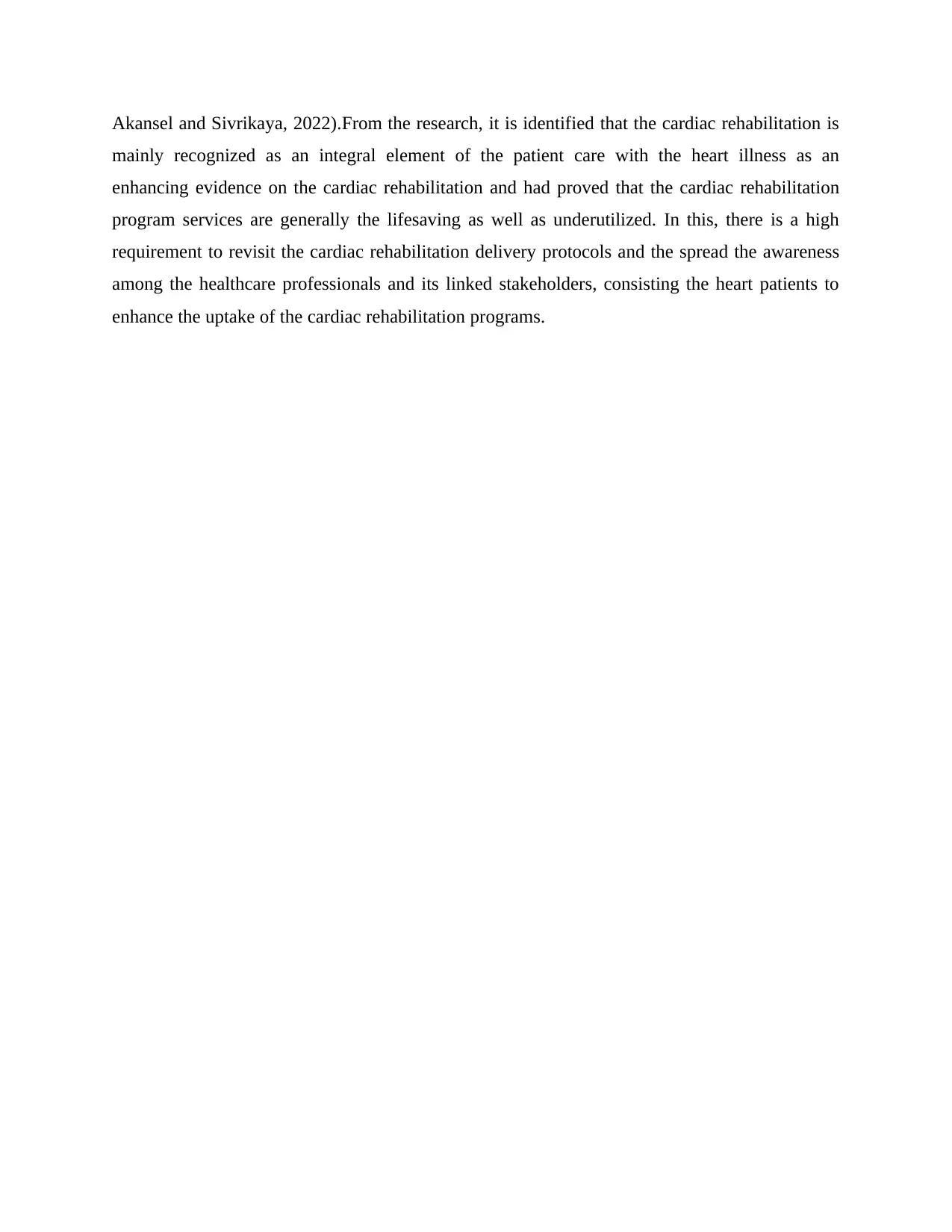
Akansel and Sivrikaya, 2022).From the research, it is identified that the cardiac rehabilitation is
mainly recognized as an integral element of the patient care with the heart illness as an
enhancing evidence on the cardiac rehabilitation and had proved that the cardiac rehabilitation
program services are generally the lifesaving as well as underutilized. In this, there is a high
requirement to revisit the cardiac rehabilitation delivery protocols and the spread the awareness
among the healthcare professionals and its linked stakeholders, consisting the heart patients to
enhance the uptake of the cardiac rehabilitation programs.
mainly recognized as an integral element of the patient care with the heart illness as an
enhancing evidence on the cardiac rehabilitation and had proved that the cardiac rehabilitation
program services are generally the lifesaving as well as underutilized. In this, there is a high
requirement to revisit the cardiac rehabilitation delivery protocols and the spread the awareness
among the healthcare professionals and its linked stakeholders, consisting the heart patients to
enhance the uptake of the cardiac rehabilitation programs.
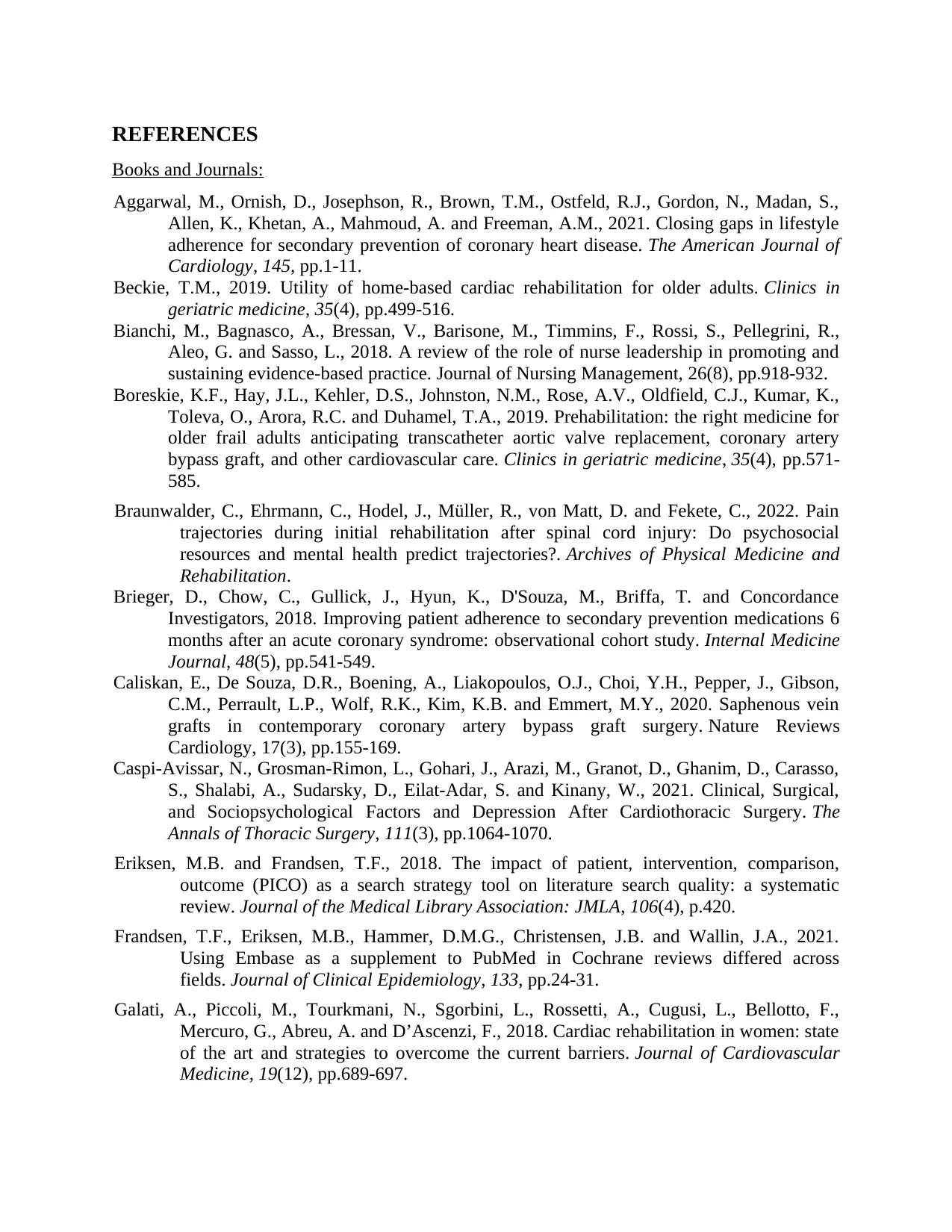
REFERENCES
Books and Journals:
Aggarwal, M., Ornish, D., Josephson, R., Brown, T.M., Ostfeld, R.J., Gordon, N., Madan, S.,
Allen, K., Khetan, A., Mahmoud, A. and Freeman, A.M., 2021. Closing gaps in lifestyle
adherence for secondary prevention of coronary heart disease. The American Journal of
Cardiology, 145, pp.1-11.
Beckie, T.M., 2019. Utility of home-based cardiac rehabilitation for older adults. Clinics in
geriatric medicine, 35(4), pp.499-516.
Bianchi, M., Bagnasco, A., Bressan, V., Barisone, M., Timmins, F., Rossi, S., Pellegrini, R.,
Aleo, G. and Sasso, L., 2018. A review of the role of nurse leadership in promoting and
sustaining evidence‐based practice. Journal of Nursing Management, 26(8), pp.918-932.
Boreskie, K.F., Hay, J.L., Kehler, D.S., Johnston, N.M., Rose, A.V., Oldfield, C.J., Kumar, K.,
Toleva, O., Arora, R.C. and Duhamel, T.A., 2019. Prehabilitation: the right medicine for
older frail adults anticipating transcatheter aortic valve replacement, coronary artery
bypass graft, and other cardiovascular care. Clinics in geriatric medicine, 35(4), pp.571-
585.
Braunwalder, C., Ehrmann, C., Hodel, J., Müller, R., von Matt, D. and Fekete, C., 2022. Pain
trajectories during initial rehabilitation after spinal cord injury: Do psychosocial
resources and mental health predict trajectories?. Archives of Physical Medicine and
Rehabilitation.
Brieger, D., Chow, C., Gullick, J., Hyun, K., D'Souza, M., Briffa, T. and Concordance
Investigators, 2018. Improving patient adherence to secondary prevention medications 6
months after an acute coronary syndrome: observational cohort study. Internal Medicine
Journal, 48(5), pp.541-549.
Caliskan, E., De Souza, D.R., Boening, A., Liakopoulos, O.J., Choi, Y.H., Pepper, J., Gibson,
C.M., Perrault, L.P., Wolf, R.K., Kim, K.B. and Emmert, M.Y., 2020. Saphenous vein
grafts in contemporary coronary artery bypass graft surgery. Nature Reviews
Cardiology, 17(3), pp.155-169.
Caspi-Avissar, N., Grosman-Rimon, L., Gohari, J., Arazi, M., Granot, D., Ghanim, D., Carasso,
S., Shalabi, A., Sudarsky, D., Eilat-Adar, S. and Kinany, W., 2021. Clinical, Surgical,
and Sociopsychological Factors and Depression After Cardiothoracic Surgery. The
Annals of Thoracic Surgery, 111(3), pp.1064-1070.
Eriksen, M.B. and Frandsen, T.F., 2018. The impact of patient, intervention, comparison,
outcome (PICO) as a search strategy tool on literature search quality: a systematic
review. Journal of the Medical Library Association: JMLA, 106(4), p.420.
Frandsen, T.F., Eriksen, M.B., Hammer, D.M.G., Christensen, J.B. and Wallin, J.A., 2021.
Using Embase as a supplement to PubMed in Cochrane reviews differed across
fields. Journal of Clinical Epidemiology, 133, pp.24-31.
Galati, A., Piccoli, M., Tourkmani, N., Sgorbini, L., Rossetti, A., Cugusi, L., Bellotto, F.,
Mercuro, G., Abreu, A. and D’Ascenzi, F., 2018. Cardiac rehabilitation in women: state
of the art and strategies to overcome the current barriers. Journal of Cardiovascular
Medicine, 19(12), pp.689-697.
Books and Journals:
Aggarwal, M., Ornish, D., Josephson, R., Brown, T.M., Ostfeld, R.J., Gordon, N., Madan, S.,
Allen, K., Khetan, A., Mahmoud, A. and Freeman, A.M., 2021. Closing gaps in lifestyle
adherence for secondary prevention of coronary heart disease. The American Journal of
Cardiology, 145, pp.1-11.
Beckie, T.M., 2019. Utility of home-based cardiac rehabilitation for older adults. Clinics in
geriatric medicine, 35(4), pp.499-516.
Bianchi, M., Bagnasco, A., Bressan, V., Barisone, M., Timmins, F., Rossi, S., Pellegrini, R.,
Aleo, G. and Sasso, L., 2018. A review of the role of nurse leadership in promoting and
sustaining evidence‐based practice. Journal of Nursing Management, 26(8), pp.918-932.
Boreskie, K.F., Hay, J.L., Kehler, D.S., Johnston, N.M., Rose, A.V., Oldfield, C.J., Kumar, K.,
Toleva, O., Arora, R.C. and Duhamel, T.A., 2019. Prehabilitation: the right medicine for
older frail adults anticipating transcatheter aortic valve replacement, coronary artery
bypass graft, and other cardiovascular care. Clinics in geriatric medicine, 35(4), pp.571-
585.
Braunwalder, C., Ehrmann, C., Hodel, J., Müller, R., von Matt, D. and Fekete, C., 2022. Pain
trajectories during initial rehabilitation after spinal cord injury: Do psychosocial
resources and mental health predict trajectories?. Archives of Physical Medicine and
Rehabilitation.
Brieger, D., Chow, C., Gullick, J., Hyun, K., D'Souza, M., Briffa, T. and Concordance
Investigators, 2018. Improving patient adherence to secondary prevention medications 6
months after an acute coronary syndrome: observational cohort study. Internal Medicine
Journal, 48(5), pp.541-549.
Caliskan, E., De Souza, D.R., Boening, A., Liakopoulos, O.J., Choi, Y.H., Pepper, J., Gibson,
C.M., Perrault, L.P., Wolf, R.K., Kim, K.B. and Emmert, M.Y., 2020. Saphenous vein
grafts in contemporary coronary artery bypass graft surgery. Nature Reviews
Cardiology, 17(3), pp.155-169.
Caspi-Avissar, N., Grosman-Rimon, L., Gohari, J., Arazi, M., Granot, D., Ghanim, D., Carasso,
S., Shalabi, A., Sudarsky, D., Eilat-Adar, S. and Kinany, W., 2021. Clinical, Surgical,
and Sociopsychological Factors and Depression After Cardiothoracic Surgery. The
Annals of Thoracic Surgery, 111(3), pp.1064-1070.
Eriksen, M.B. and Frandsen, T.F., 2018. The impact of patient, intervention, comparison,
outcome (PICO) as a search strategy tool on literature search quality: a systematic
review. Journal of the Medical Library Association: JMLA, 106(4), p.420.
Frandsen, T.F., Eriksen, M.B., Hammer, D.M.G., Christensen, J.B. and Wallin, J.A., 2021.
Using Embase as a supplement to PubMed in Cochrane reviews differed across
fields. Journal of Clinical Epidemiology, 133, pp.24-31.
Galati, A., Piccoli, M., Tourkmani, N., Sgorbini, L., Rossetti, A., Cugusi, L., Bellotto, F.,
Mercuro, G., Abreu, A. and D’Ascenzi, F., 2018. Cardiac rehabilitation in women: state
of the art and strategies to overcome the current barriers. Journal of Cardiovascular
Medicine, 19(12), pp.689-697.

Hoyler, M.M., Tam, C.W., Thalappillil, R., Jiang, S., Ma, X., Lui, B. and White, R.S., 2020. The
impact of hospital safety‐net burden on mortality and readmission after CABG
surgery. Journal of Cardiac Surgery, 35(9), pp.2232-2241.
Latimer, K., 2020. The Art of Care: A Report on the 2019 Vizient Connections Education
Summit. American Journal of Medical Quality, 35(1_suppl), pp.5S-111S.
Laukkanen, J.A., 2018. Contemporary nationwide cardiology registers: up-to-date registry data
are required. European Journal of Preventive Cardiology, 25(3), pp.270-272.
Linden, W., Young, S., Ignaszewski, A. and Campbell, T., 2021. Psychosocial and medical
predictors of 14-year mortality and morbidity in male and female coronary artery
bypass graft recipients: a prospective observational study. Psychological Medicine,
pp.1-12.
Marin, T.S., Walsh, S., May, N., Jones, M., Gray, R., Muir-Cochrane, E. and Clark, R.A., 2020.
Screening for depression and anxiety among patients with acute coronary syndrome in
acute care settings: a scoping review. JBI evidence synthesis, 18(9), pp.1932-1969.
Melnyk, B.M., Gallagher‐Ford, L., Zellefrow, C., Tucker, S., Thomas, B., Sinnott, L.T. and Tan,
A., 2018. The first US study on nurses’ evidence‐based practice competencies indicates
major deficits that threaten healthcare quality, safety, and patient outcomes. Worldviews
on Evidence‐Based Nursing, 15(1), pp.16-25.
Miura, Y., Tamai, N., Kitamura, A., Yoshida, M., Takahashi, T., Mugita, Y., Tobita, I., Arita,
M., Urai, T., Dai, M. and Noguchi, H., 2021. Diagnostic accuracy of ultrasound
examination in detecting aspiration and pharyngeal residue in patients with dysphagia:
A systematic review and meta‐analysis. Japan Journal of Nursing Science, 18(2),
p.e12396.
Okati-Aliabad, H., Ansari-Moghaddam, A., Roohafza, H., Mohammadi, M., Vakili, L., Abbasi,
M.H., Heidari, H., Masoudy, G., Yazdekhasti, S. and Sadeghi, M., 2022. The effects of
comprehensive home-based cardiac rehabilitation versus usual care in patients with
ischemic heart disease in Iran: Study protocol for a multicenter randomized controlled
trial. International Journal of Preventive Medicine, 13(1), p.4.
Osailan, A. and Abdelbasset, W.K., 2020. Exercise-based cardiac rehabilitation for postcoronary
artery bypass grafting and its effect on hemodynamic responses and functional capacity
evaluated using the Incremental Shuttle Walking Test: A retrospective pilot
analysis. Journal of the Saudi Heart Association, 32(1), p.25.
Pastormerlo, L.E., Aimo, A., Piepoli, M. and Emdin, M., 2018. The bottleneck of cardiac
rehabilitation for patients with coronary artery disease: How to overcome. European
Journal of Preventive Cardiology, 25(12), pp.1239-1241.
Pedersen, M., Egerod, I., Overgaard, D., Baastrup, M. and Andersen, I., 2018. Social inequality
in phase II cardiac rehabilitation attendance: The impact of potential
mediators. European Journal of Cardiovascular Nursing, 17(4), pp.345-355.
Samuel, R., Alfadhel, M., McAlister, C., Nestelberger, T. and Saw, J., 2021. Cardiac
rehabilitation following coronary artery dissection: recommendations and patient
considerations. Expert review of cardiovascular therapy, 19(11), pp.1005-1012.
Santoft, F., Axelsson, E., Öst, L.G., Hedman-Lagerlöf, M., Fust, J. and Hedman-Lagerlöf, E.,
2019. Cognitive behaviour therapy for depression in primary care: systematic review and
meta-analysis. Psychological medicine, 49(8), pp.1266-1274.
impact of hospital safety‐net burden on mortality and readmission after CABG
surgery. Journal of Cardiac Surgery, 35(9), pp.2232-2241.
Latimer, K., 2020. The Art of Care: A Report on the 2019 Vizient Connections Education
Summit. American Journal of Medical Quality, 35(1_suppl), pp.5S-111S.
Laukkanen, J.A., 2018. Contemporary nationwide cardiology registers: up-to-date registry data
are required. European Journal of Preventive Cardiology, 25(3), pp.270-272.
Linden, W., Young, S., Ignaszewski, A. and Campbell, T., 2021. Psychosocial and medical
predictors of 14-year mortality and morbidity in male and female coronary artery
bypass graft recipients: a prospective observational study. Psychological Medicine,
pp.1-12.
Marin, T.S., Walsh, S., May, N., Jones, M., Gray, R., Muir-Cochrane, E. and Clark, R.A., 2020.
Screening for depression and anxiety among patients with acute coronary syndrome in
acute care settings: a scoping review. JBI evidence synthesis, 18(9), pp.1932-1969.
Melnyk, B.M., Gallagher‐Ford, L., Zellefrow, C., Tucker, S., Thomas, B., Sinnott, L.T. and Tan,
A., 2018. The first US study on nurses’ evidence‐based practice competencies indicates
major deficits that threaten healthcare quality, safety, and patient outcomes. Worldviews
on Evidence‐Based Nursing, 15(1), pp.16-25.
Miura, Y., Tamai, N., Kitamura, A., Yoshida, M., Takahashi, T., Mugita, Y., Tobita, I., Arita,
M., Urai, T., Dai, M. and Noguchi, H., 2021. Diagnostic accuracy of ultrasound
examination in detecting aspiration and pharyngeal residue in patients with dysphagia:
A systematic review and meta‐analysis. Japan Journal of Nursing Science, 18(2),
p.e12396.
Okati-Aliabad, H., Ansari-Moghaddam, A., Roohafza, H., Mohammadi, M., Vakili, L., Abbasi,
M.H., Heidari, H., Masoudy, G., Yazdekhasti, S. and Sadeghi, M., 2022. The effects of
comprehensive home-based cardiac rehabilitation versus usual care in patients with
ischemic heart disease in Iran: Study protocol for a multicenter randomized controlled
trial. International Journal of Preventive Medicine, 13(1), p.4.
Osailan, A. and Abdelbasset, W.K., 2020. Exercise-based cardiac rehabilitation for postcoronary
artery bypass grafting and its effect on hemodynamic responses and functional capacity
evaluated using the Incremental Shuttle Walking Test: A retrospective pilot
analysis. Journal of the Saudi Heart Association, 32(1), p.25.
Pastormerlo, L.E., Aimo, A., Piepoli, M. and Emdin, M., 2018. The bottleneck of cardiac
rehabilitation for patients with coronary artery disease: How to overcome. European
Journal of Preventive Cardiology, 25(12), pp.1239-1241.
Pedersen, M., Egerod, I., Overgaard, D., Baastrup, M. and Andersen, I., 2018. Social inequality
in phase II cardiac rehabilitation attendance: The impact of potential
mediators. European Journal of Cardiovascular Nursing, 17(4), pp.345-355.
Samuel, R., Alfadhel, M., McAlister, C., Nestelberger, T. and Saw, J., 2021. Cardiac
rehabilitation following coronary artery dissection: recommendations and patient
considerations. Expert review of cardiovascular therapy, 19(11), pp.1005-1012.
Santoft, F., Axelsson, E., Öst, L.G., Hedman-Lagerlöf, M., Fust, J. and Hedman-Lagerlöf, E.,
2019. Cognitive behaviour therapy for depression in primary care: systematic review and
meta-analysis. Psychological medicine, 49(8), pp.1266-1274.
Secure Best Marks with AI Grader
Need help grading? Try our AI Grader for instant feedback on your assignments.
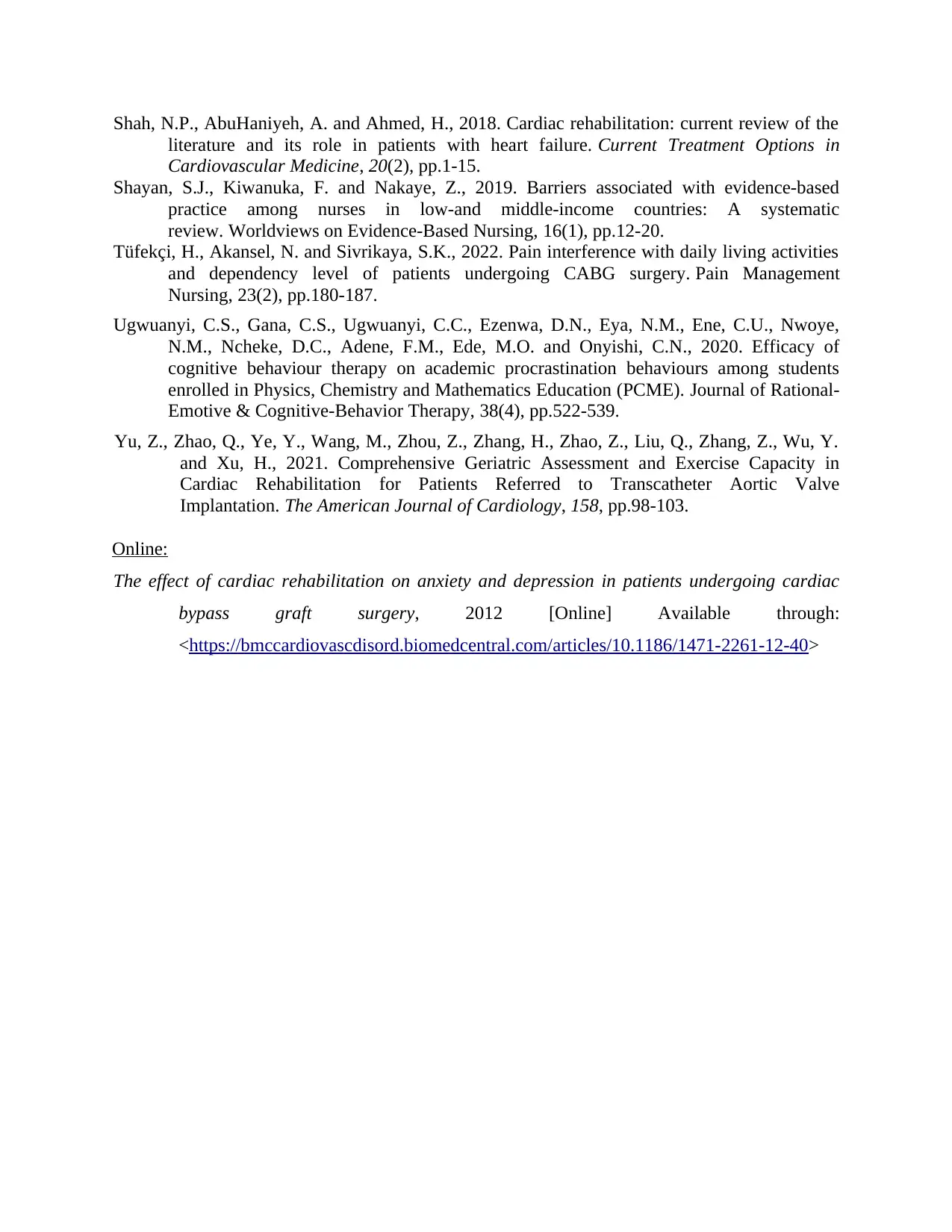
Shah, N.P., AbuHaniyeh, A. and Ahmed, H., 2018. Cardiac rehabilitation: current review of the
literature and its role in patients with heart failure. Current Treatment Options in
Cardiovascular Medicine, 20(2), pp.1-15.
Shayan, S.J., Kiwanuka, F. and Nakaye, Z., 2019. Barriers associated with evidence‐based
practice among nurses in low‐and middle‐income countries: A systematic
review. Worldviews on Evidence‐Based Nursing, 16(1), pp.12-20.
Tüfekçi, H., Akansel, N. and Sivrikaya, S.K., 2022. Pain interference with daily living activities
and dependency level of patients undergoing CABG surgery. Pain Management
Nursing, 23(2), pp.180-187.
Ugwuanyi, C.S., Gana, C.S., Ugwuanyi, C.C., Ezenwa, D.N., Eya, N.M., Ene, C.U., Nwoye,
N.M., Ncheke, D.C., Adene, F.M., Ede, M.O. and Onyishi, C.N., 2020. Efficacy of
cognitive behaviour therapy on academic procrastination behaviours among students
enrolled in Physics, Chemistry and Mathematics Education (PCME). Journal of Rational-
Emotive & Cognitive-Behavior Therapy, 38(4), pp.522-539.
Yu, Z., Zhao, Q., Ye, Y., Wang, M., Zhou, Z., Zhang, H., Zhao, Z., Liu, Q., Zhang, Z., Wu, Y.
and Xu, H., 2021. Comprehensive Geriatric Assessment and Exercise Capacity in
Cardiac Rehabilitation for Patients Referred to Transcatheter Aortic Valve
Implantation. The American Journal of Cardiology, 158, pp.98-103.
Online:
The effect of cardiac rehabilitation on anxiety and depression in patients undergoing cardiac
bypass graft surgery, 2012 [Online] Available through:
<https://bmccardiovascdisord.biomedcentral.com/articles/10.1186/1471-2261-12-40>
literature and its role in patients with heart failure. Current Treatment Options in
Cardiovascular Medicine, 20(2), pp.1-15.
Shayan, S.J., Kiwanuka, F. and Nakaye, Z., 2019. Barriers associated with evidence‐based
practice among nurses in low‐and middle‐income countries: A systematic
review. Worldviews on Evidence‐Based Nursing, 16(1), pp.12-20.
Tüfekçi, H., Akansel, N. and Sivrikaya, S.K., 2022. Pain interference with daily living activities
and dependency level of patients undergoing CABG surgery. Pain Management
Nursing, 23(2), pp.180-187.
Ugwuanyi, C.S., Gana, C.S., Ugwuanyi, C.C., Ezenwa, D.N., Eya, N.M., Ene, C.U., Nwoye,
N.M., Ncheke, D.C., Adene, F.M., Ede, M.O. and Onyishi, C.N., 2020. Efficacy of
cognitive behaviour therapy on academic procrastination behaviours among students
enrolled in Physics, Chemistry and Mathematics Education (PCME). Journal of Rational-
Emotive & Cognitive-Behavior Therapy, 38(4), pp.522-539.
Yu, Z., Zhao, Q., Ye, Y., Wang, M., Zhou, Z., Zhang, H., Zhao, Z., Liu, Q., Zhang, Z., Wu, Y.
and Xu, H., 2021. Comprehensive Geriatric Assessment and Exercise Capacity in
Cardiac Rehabilitation for Patients Referred to Transcatheter Aortic Valve
Implantation. The American Journal of Cardiology, 158, pp.98-103.
Online:
The effect of cardiac rehabilitation on anxiety and depression in patients undergoing cardiac
bypass graft surgery, 2012 [Online] Available through:
<https://bmccardiovascdisord.biomedcentral.com/articles/10.1186/1471-2261-12-40>
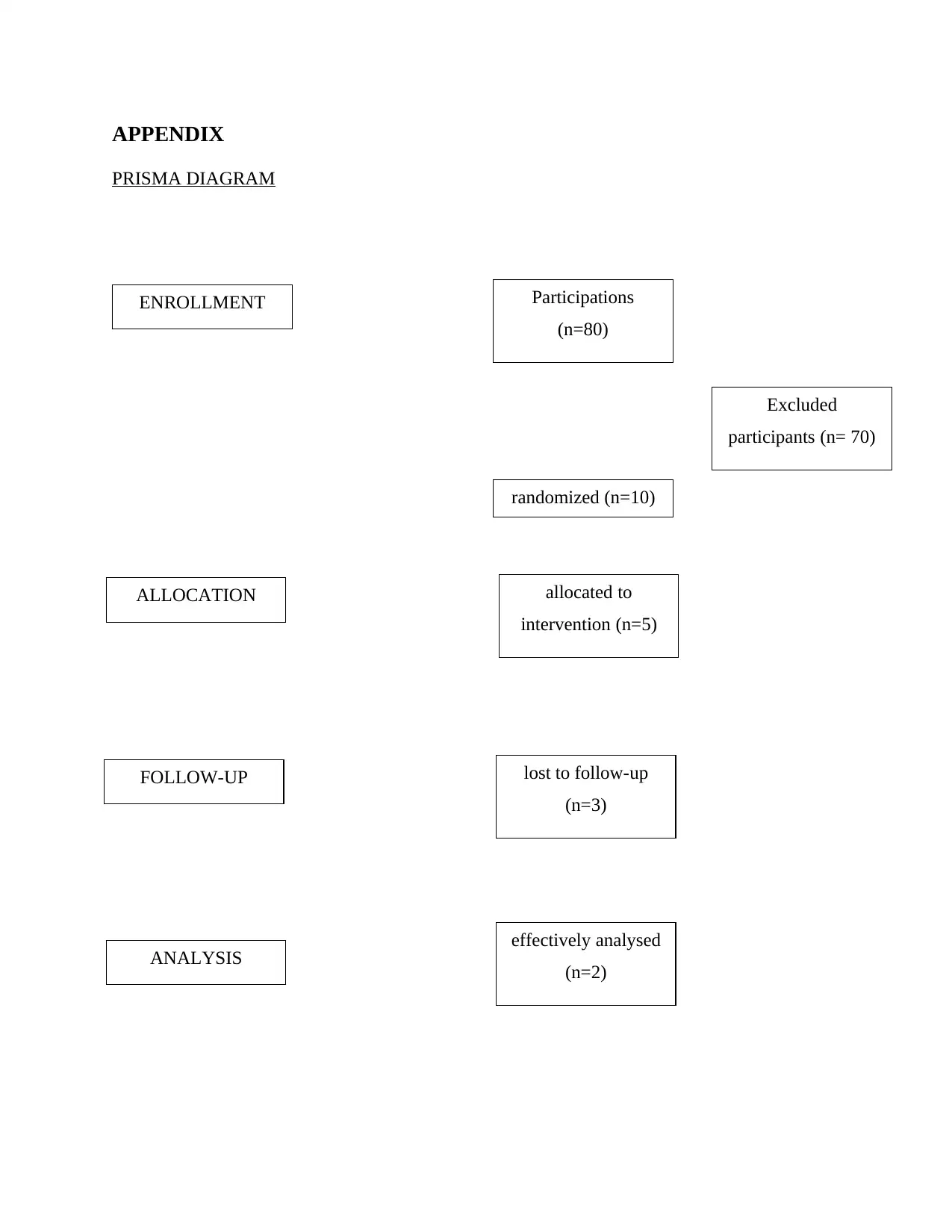
APPENDIX
PRISMA DIAGRAM
ENROLLMENT
ALLOCATION
FOLLOW-UP
ANALYSIS
Participations
(n=80)
Excluded
participants (n= 70)
randomized (n=10)
allocated to
intervention (n=5)
lost to follow-up
(n=3)
effectively analysed
(n=2)
PRISMA DIAGRAM
ENROLLMENT
ALLOCATION
FOLLOW-UP
ANALYSIS
Participations
(n=80)
Excluded
participants (n= 70)
randomized (n=10)
allocated to
intervention (n=5)
lost to follow-up
(n=3)
effectively analysed
(n=2)
1 out of 18
Related Documents
Your All-in-One AI-Powered Toolkit for Academic Success.
+13062052269
info@desklib.com
Available 24*7 on WhatsApp / Email
![[object Object]](/_next/static/media/star-bottom.7253800d.svg)
Unlock your academic potential
© 2024 | Zucol Services PVT LTD | All rights reserved.





